BIOPOLITICS The Political Potential of the Life Sciences.

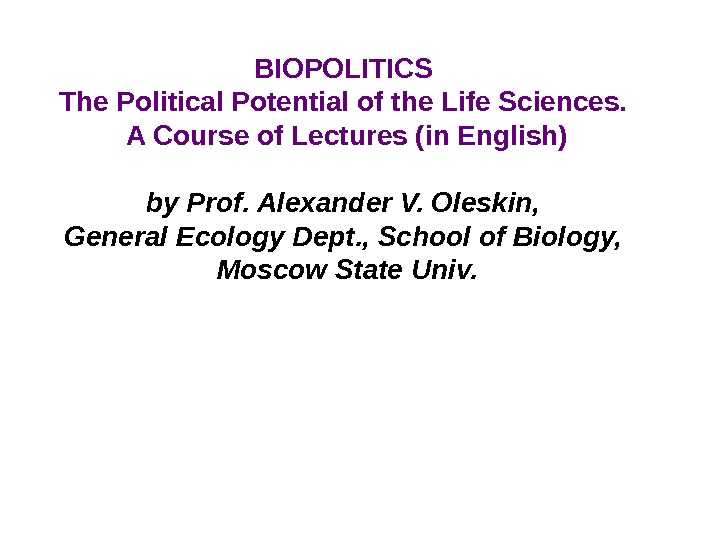
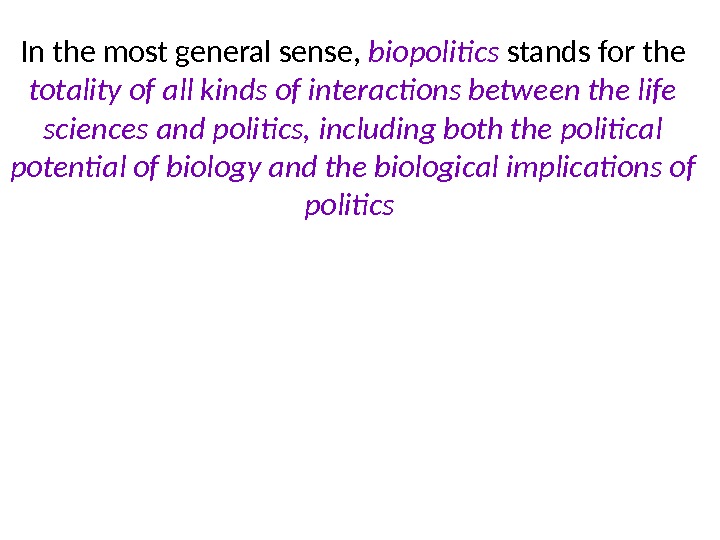
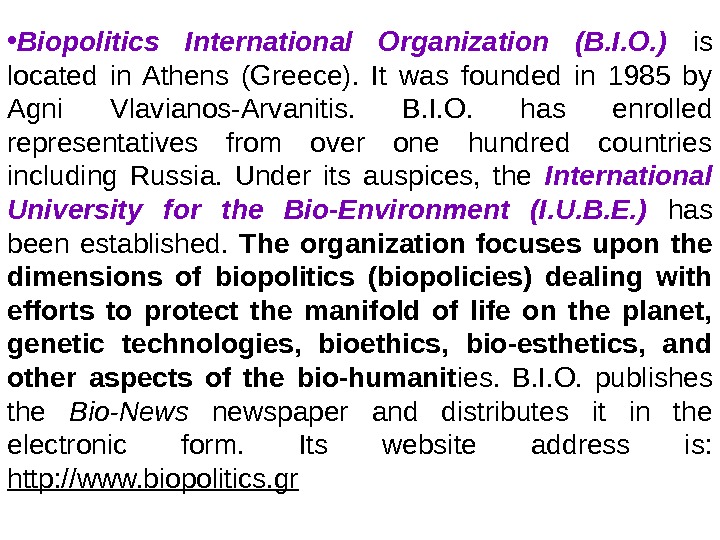
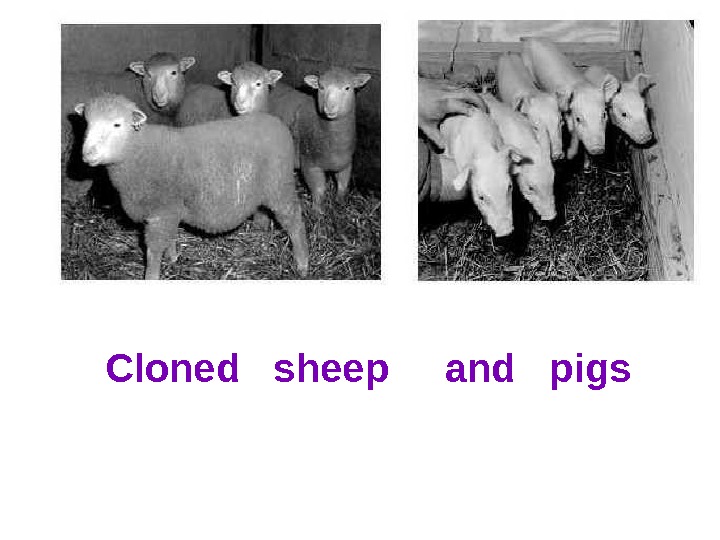

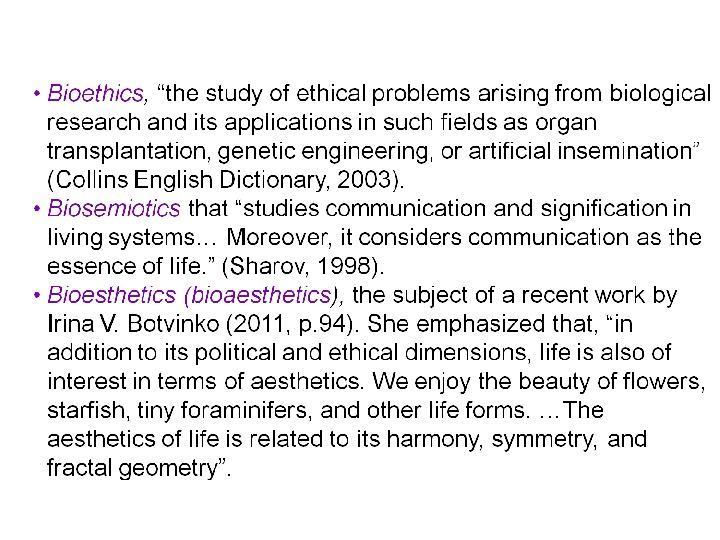
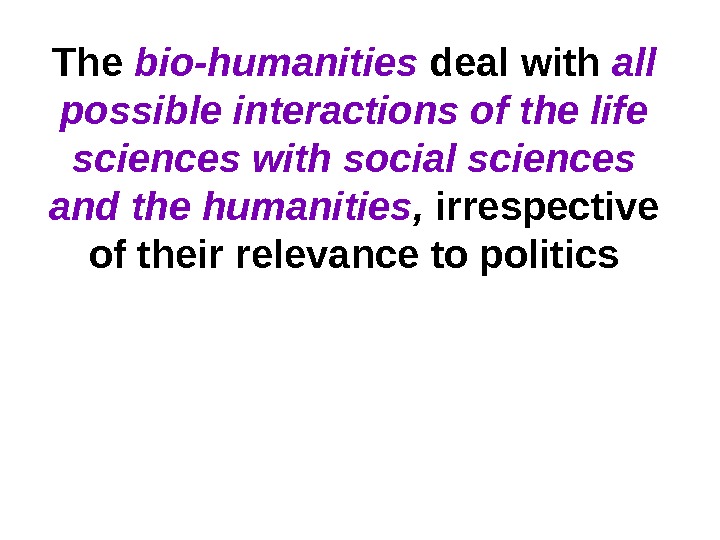

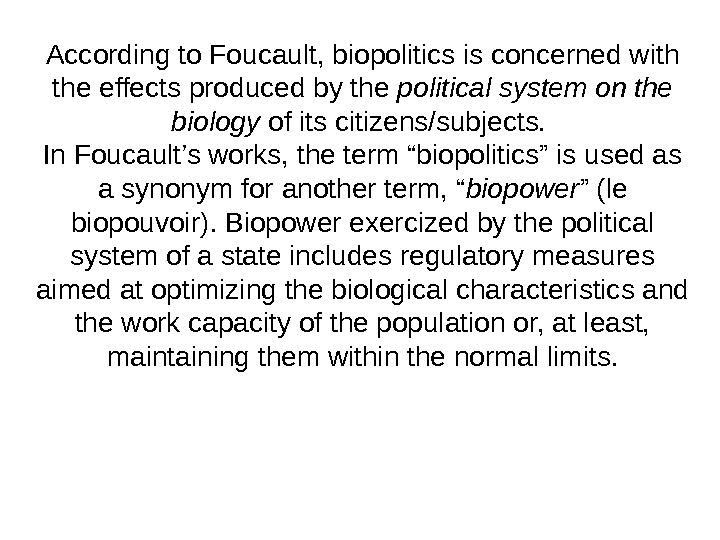
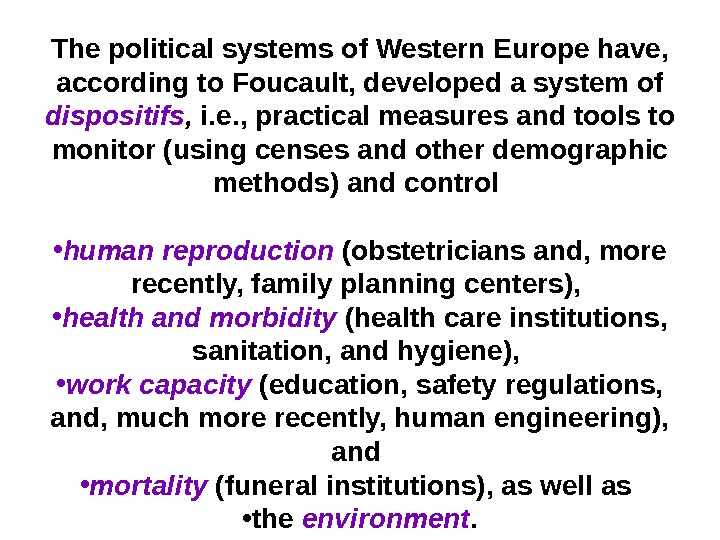
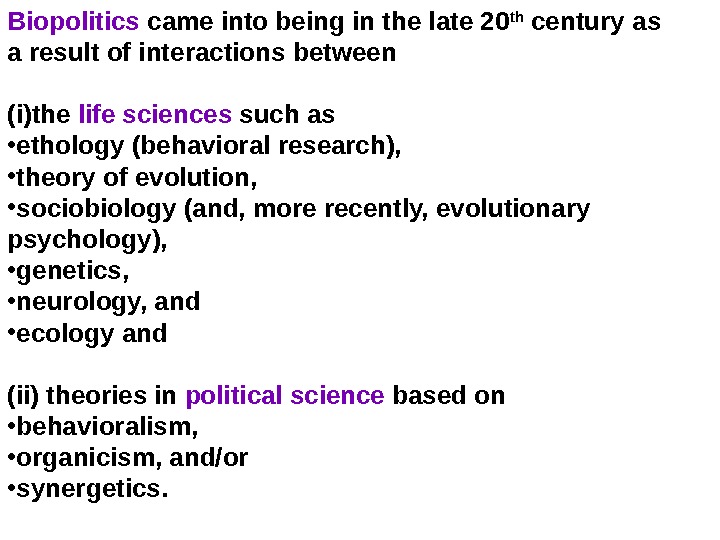
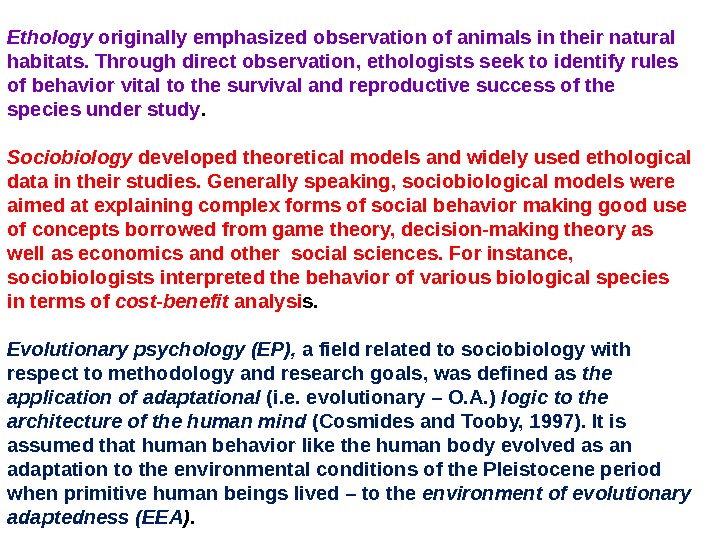
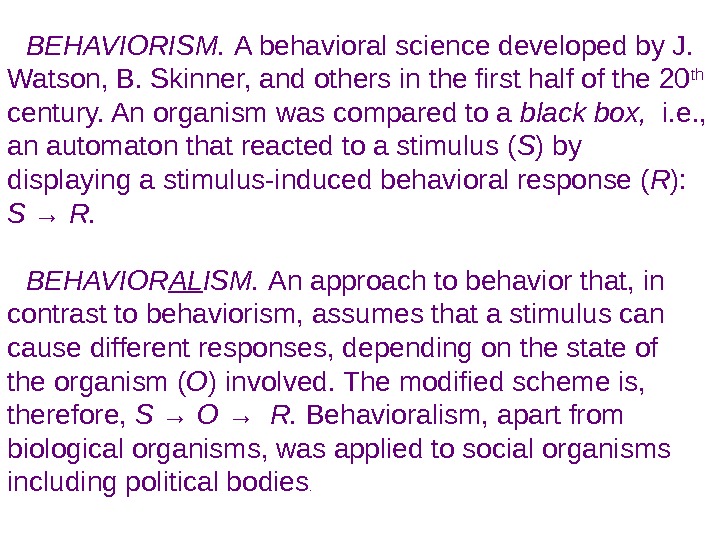
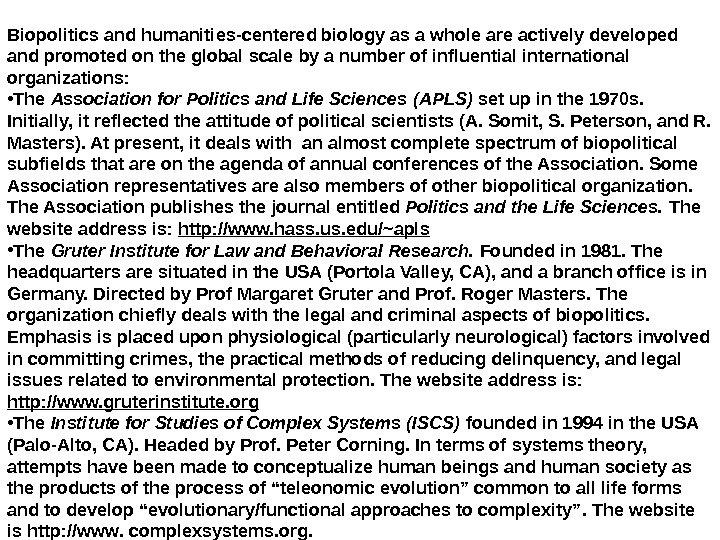
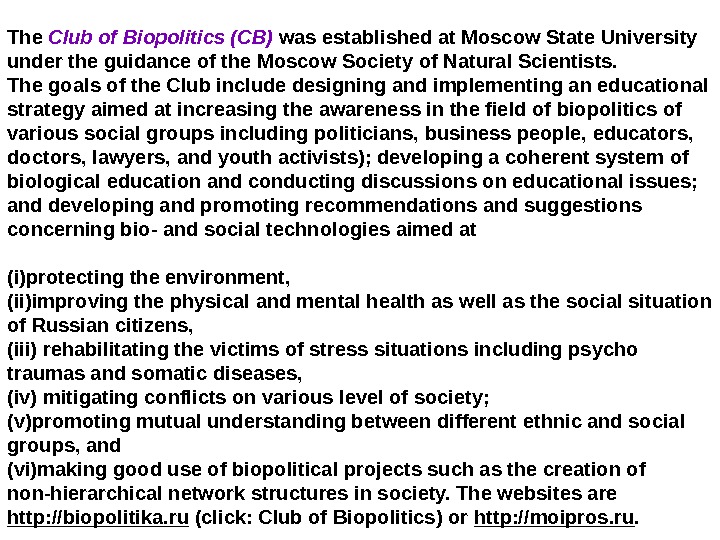
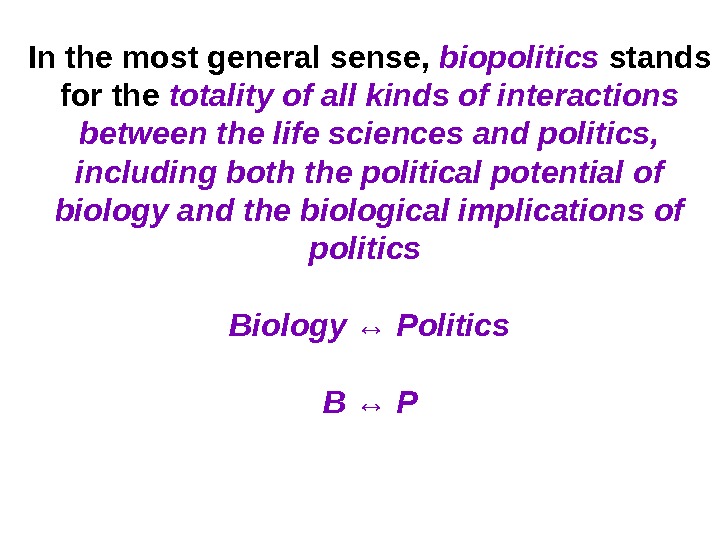
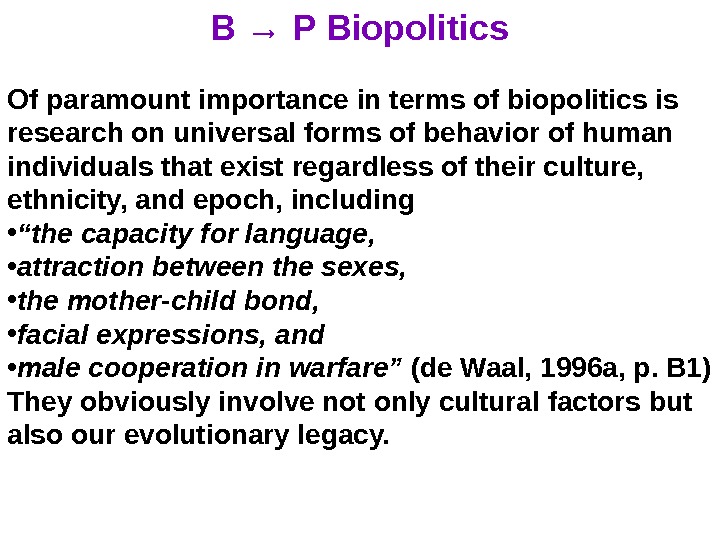

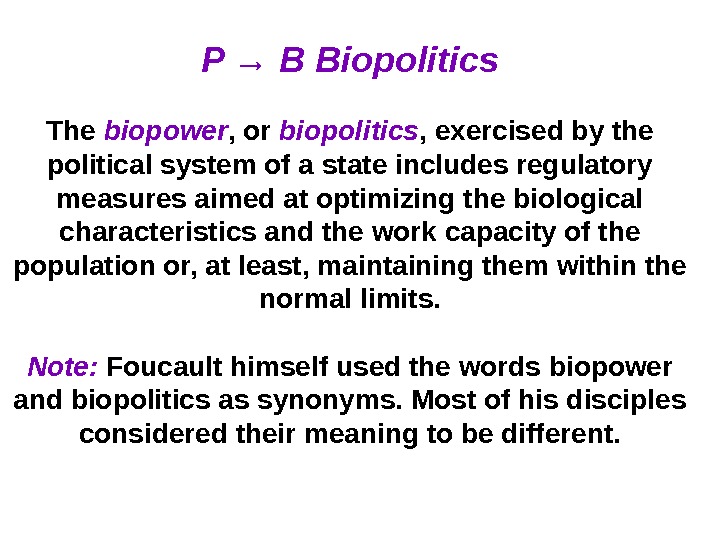
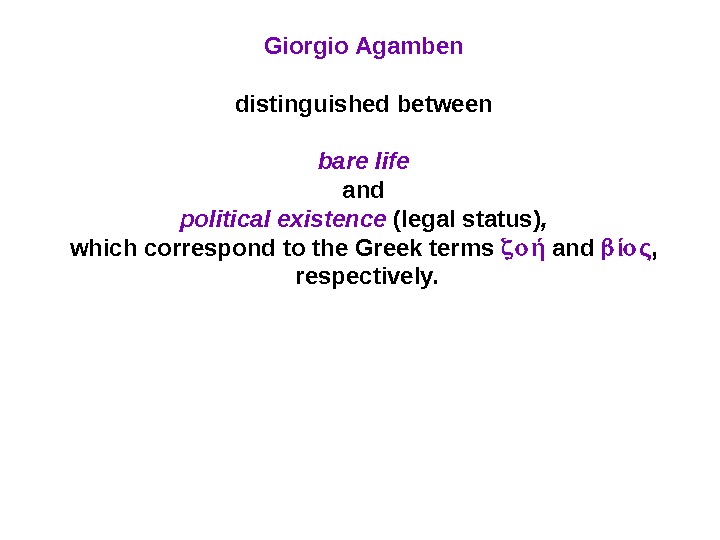
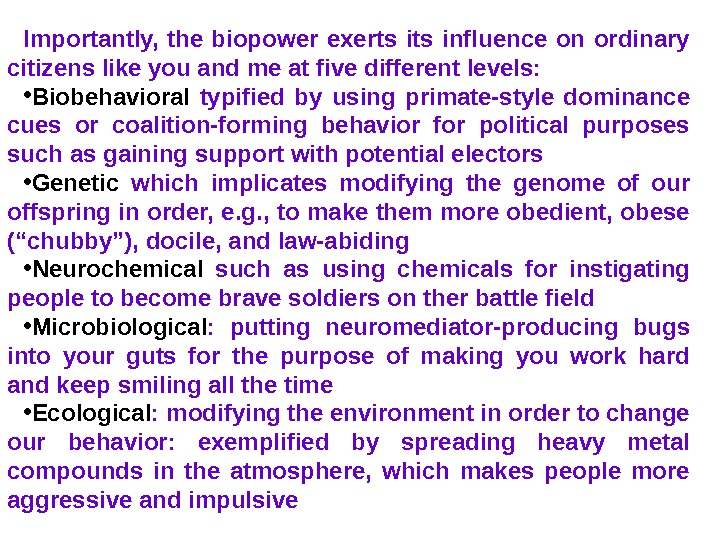
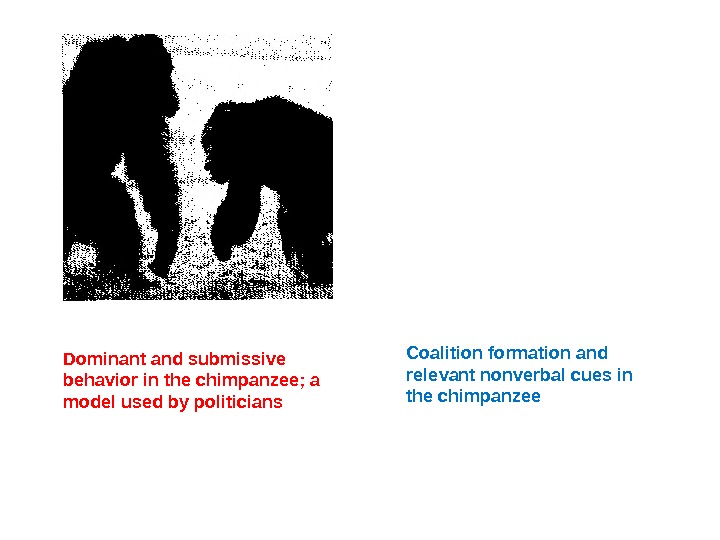
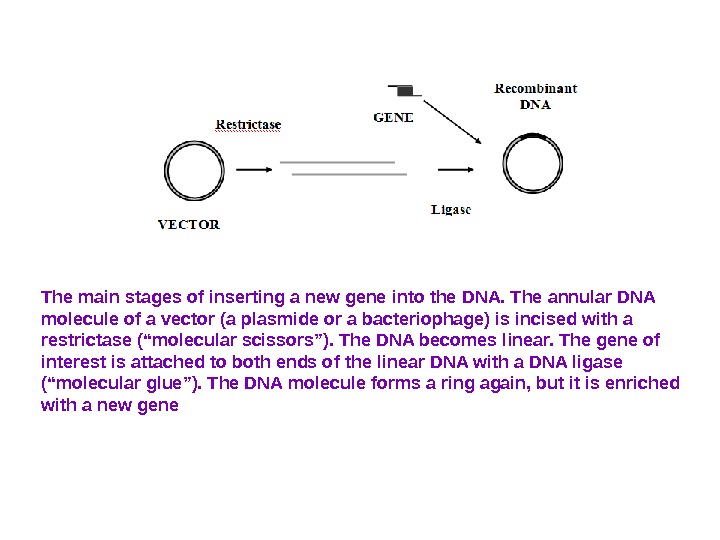
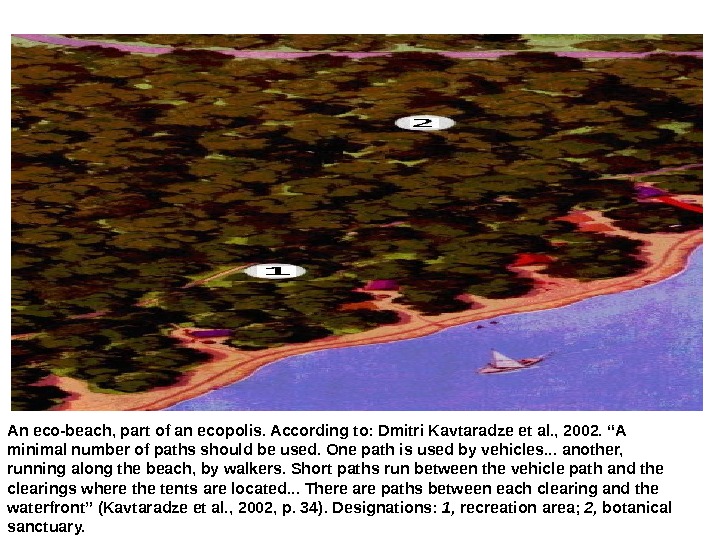
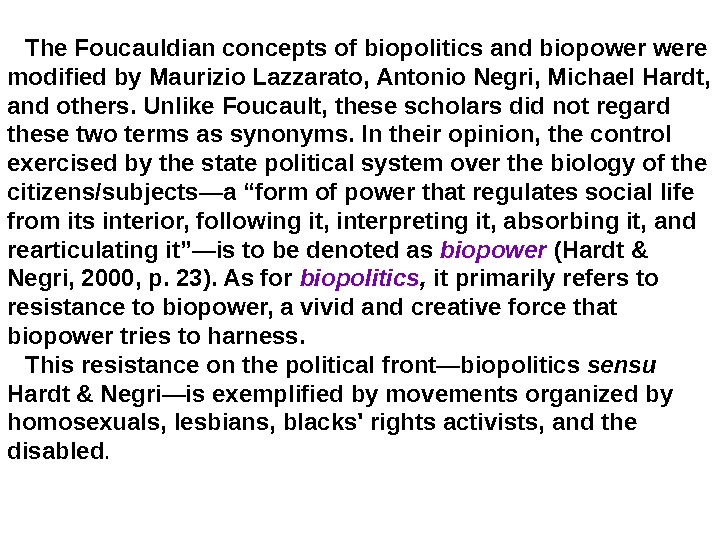

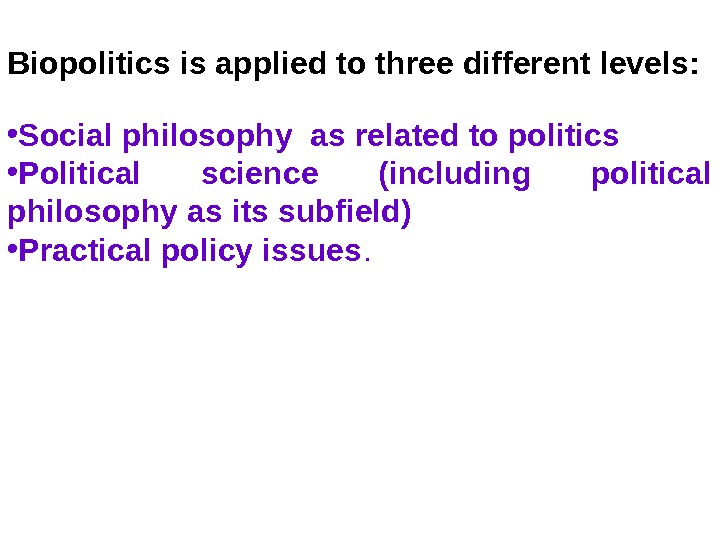
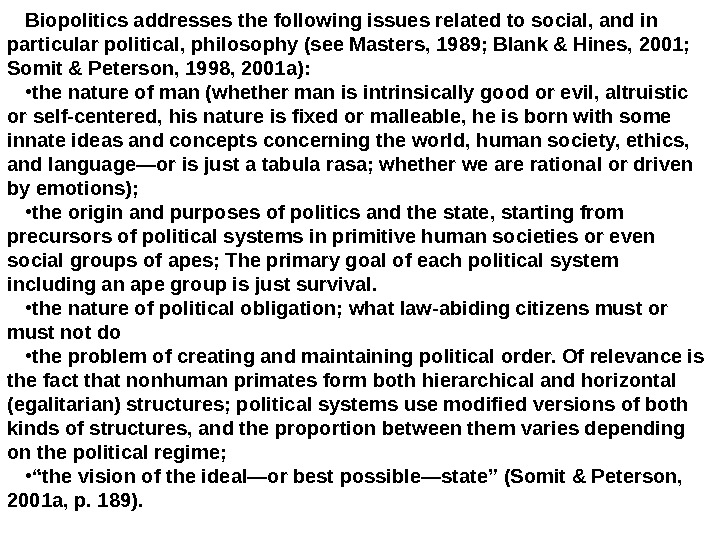
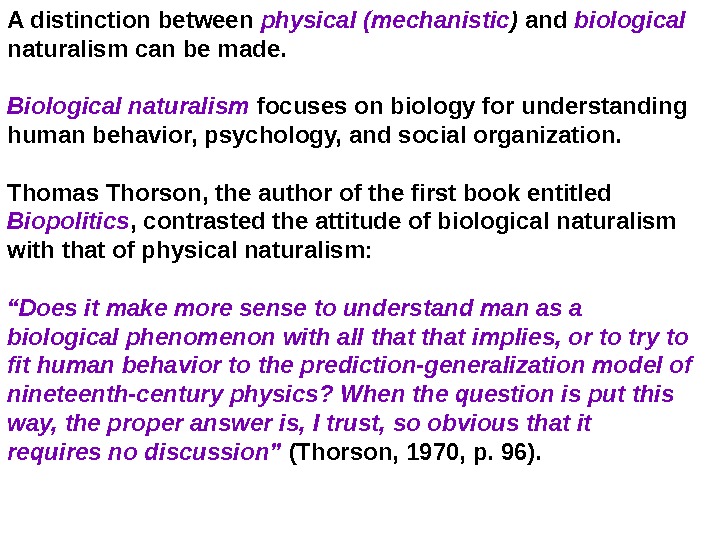
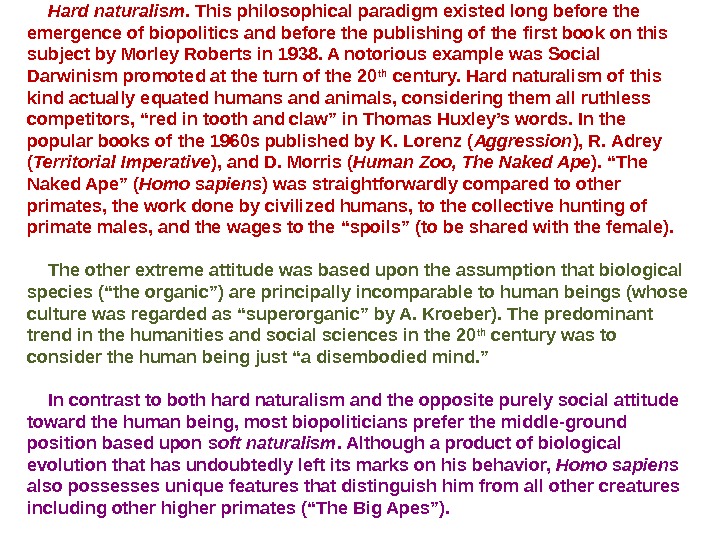
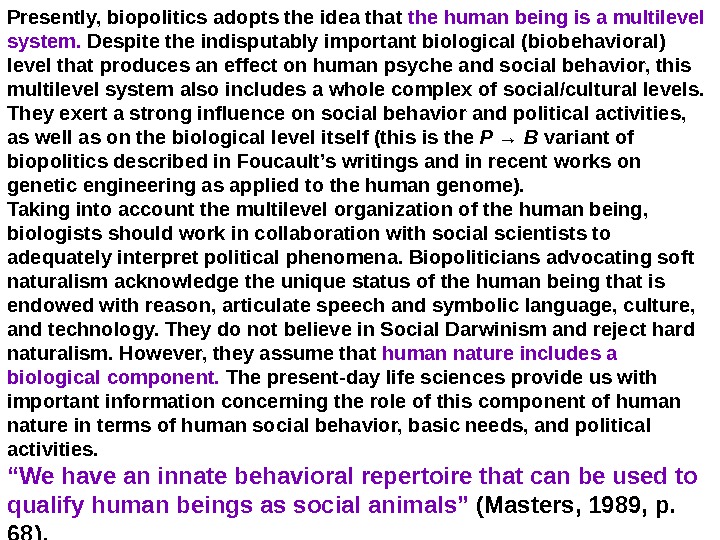
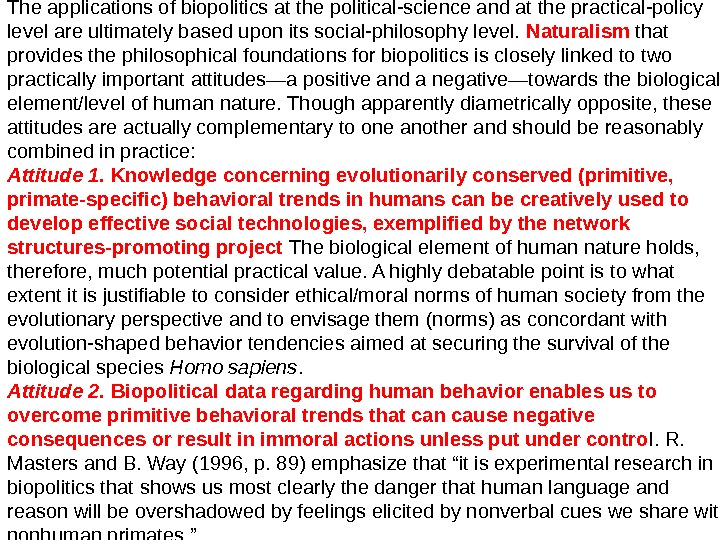
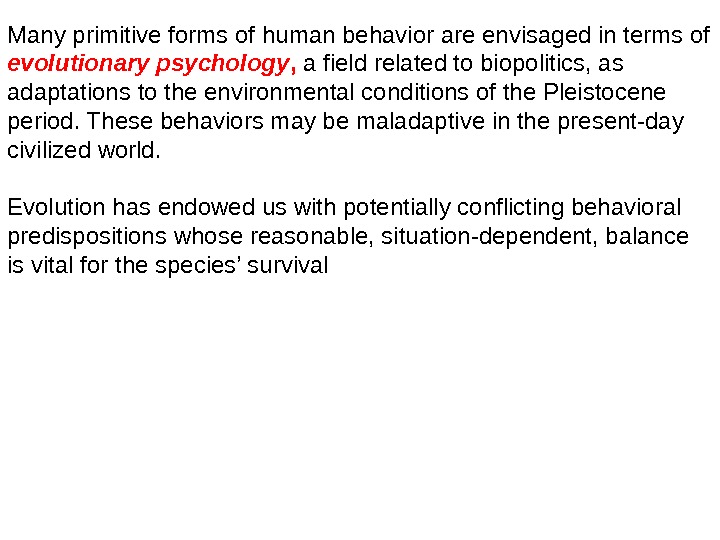
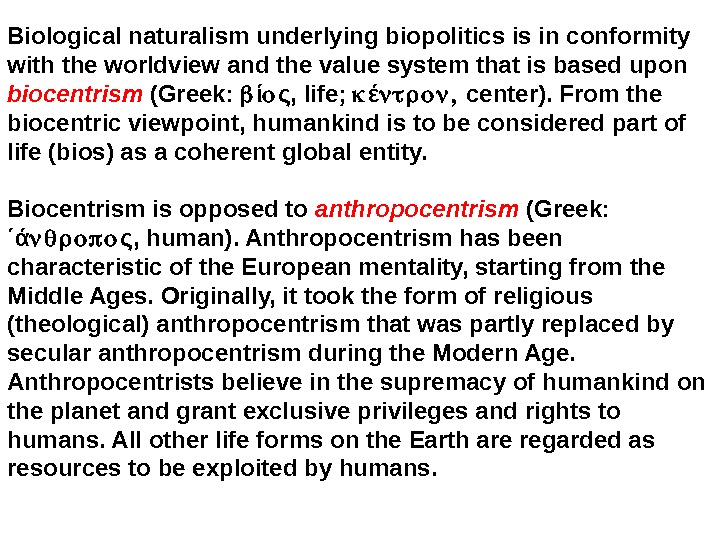
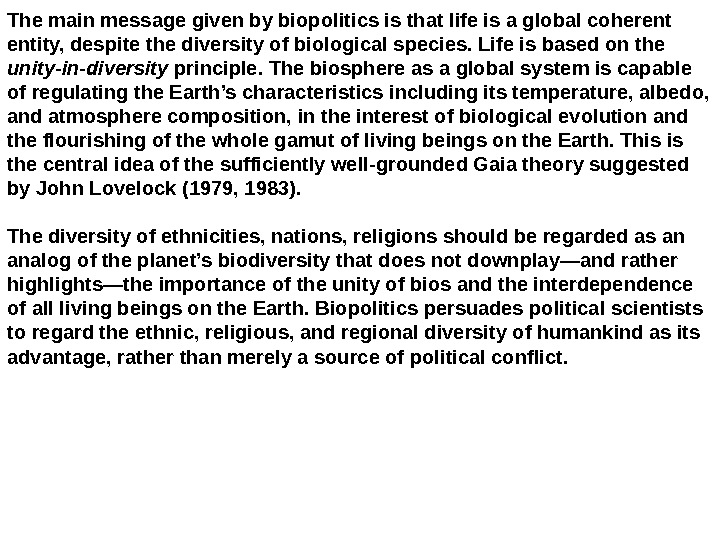
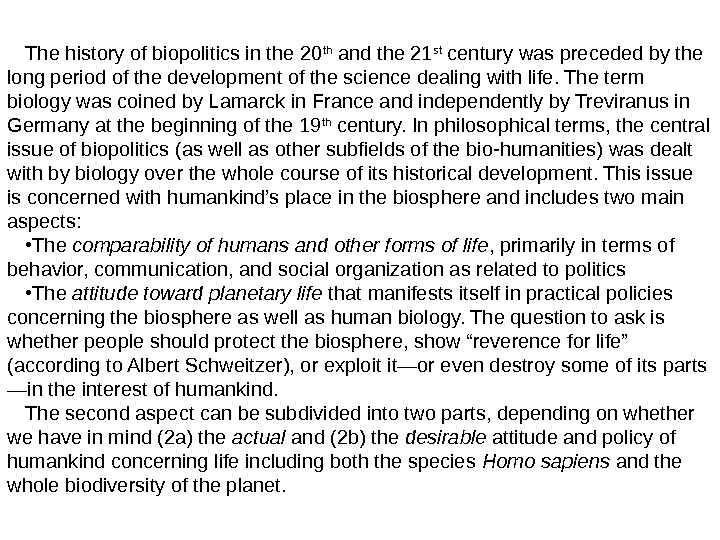
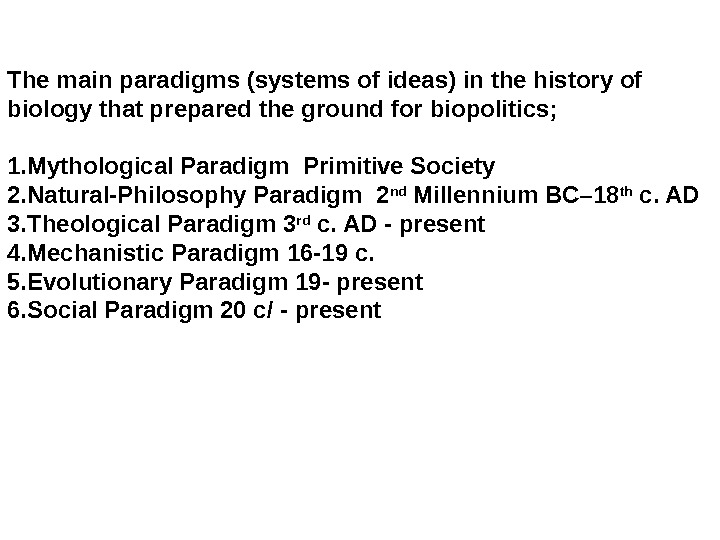
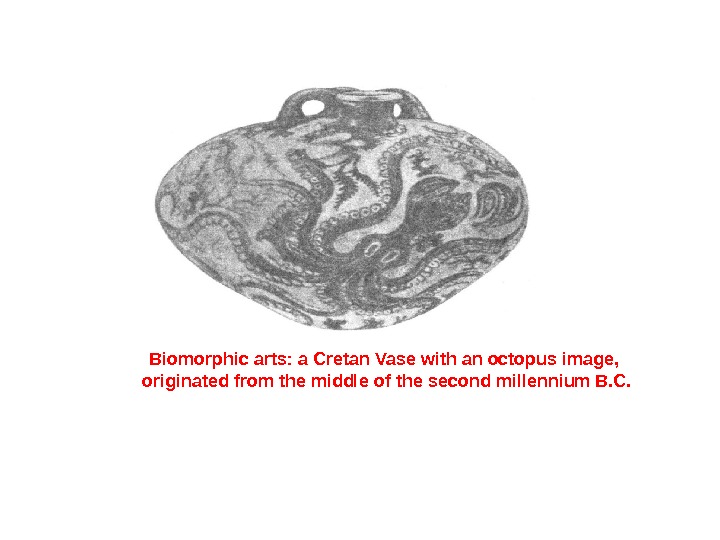
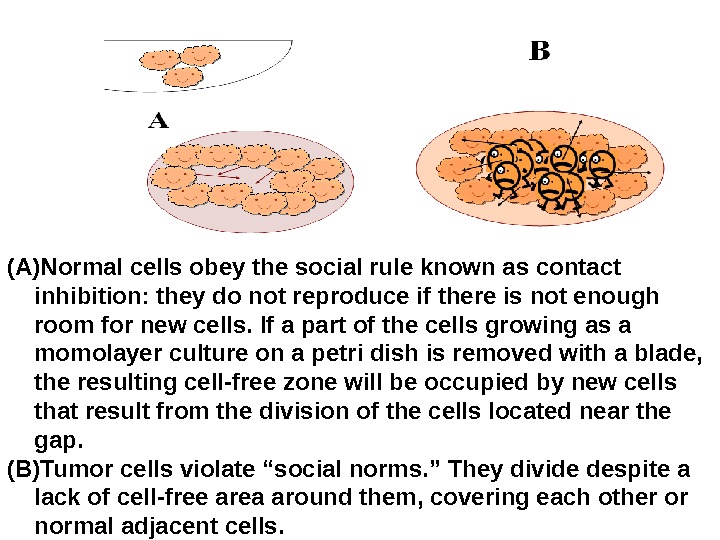
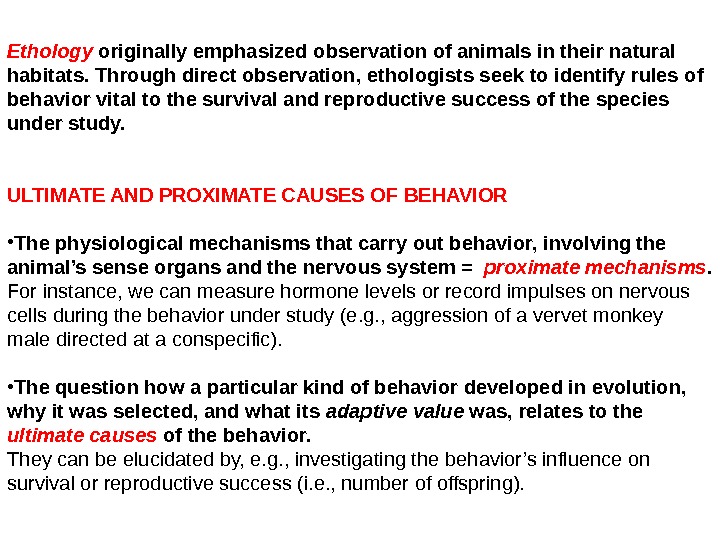
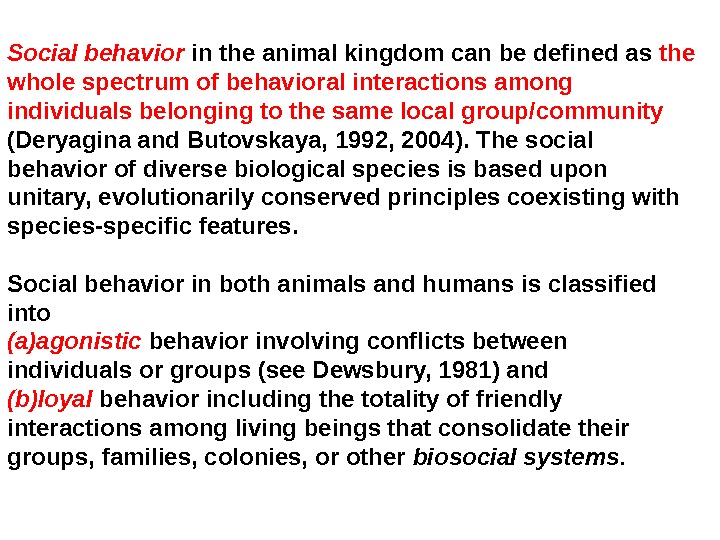
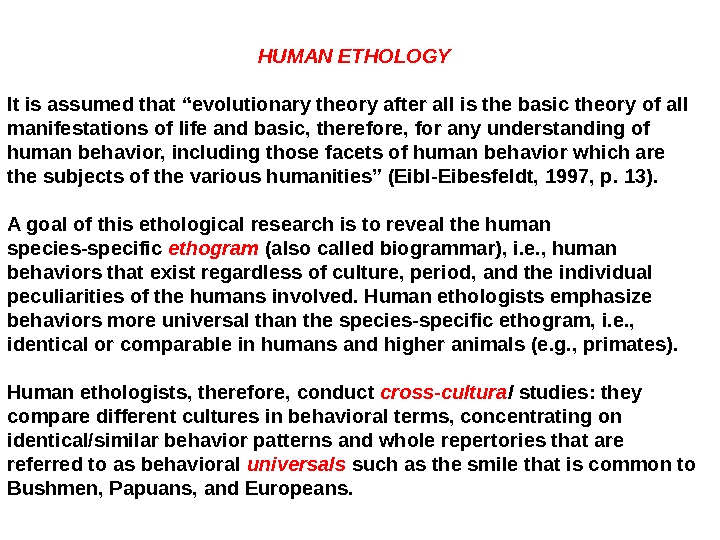
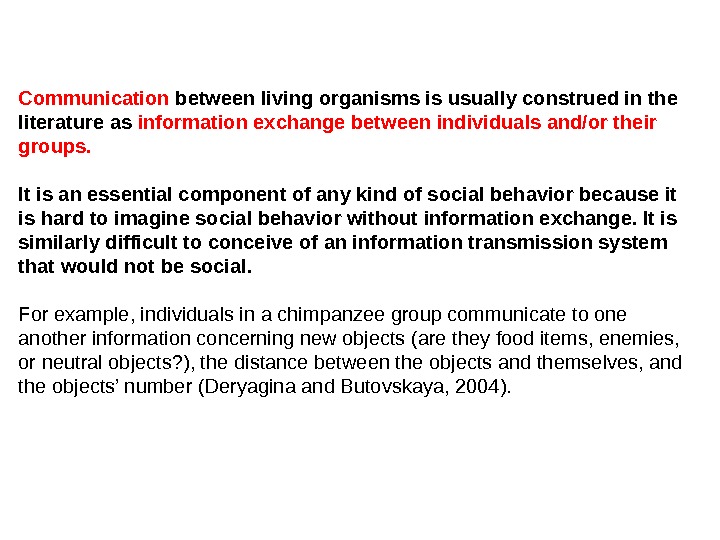
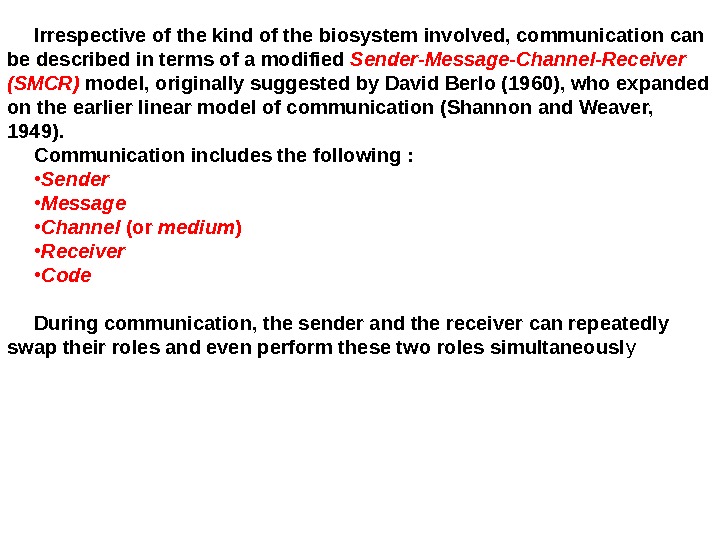
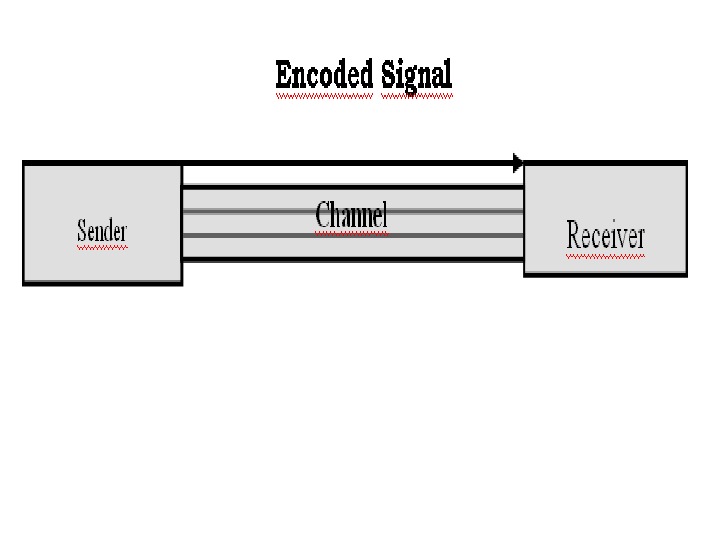
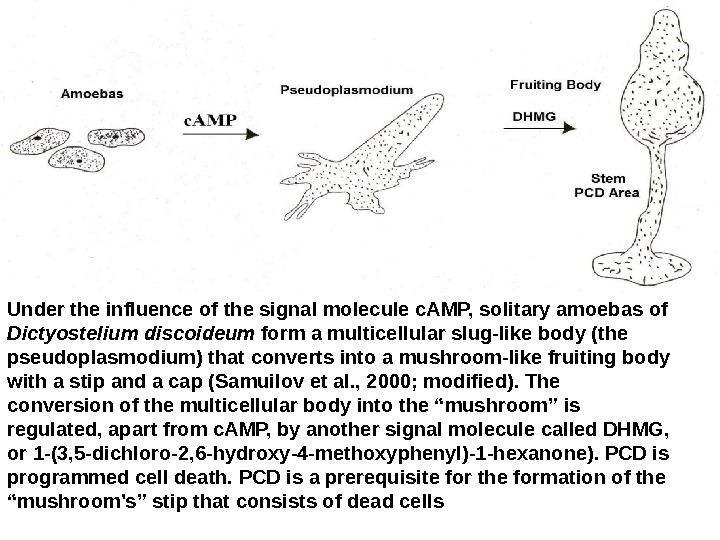
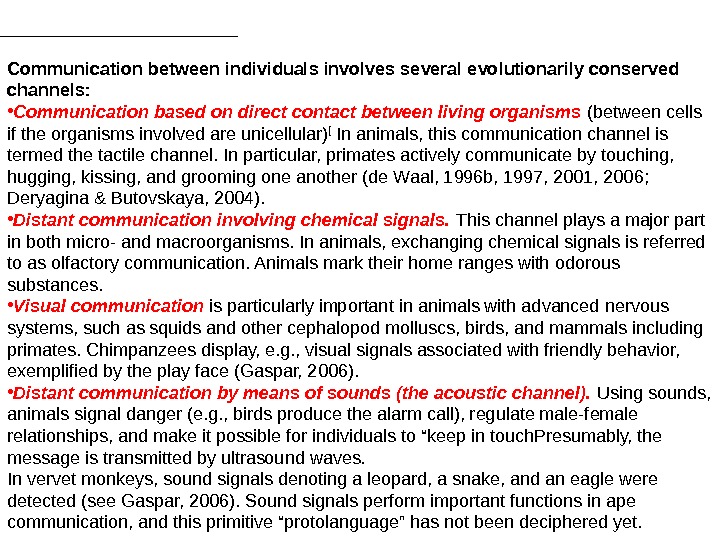
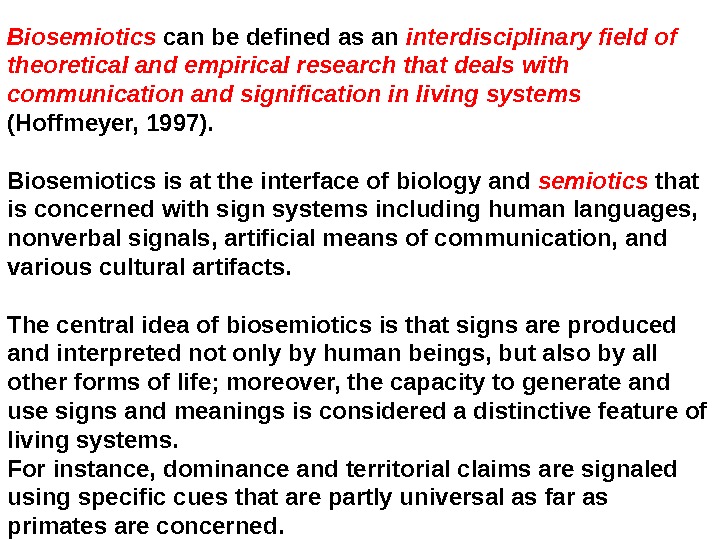
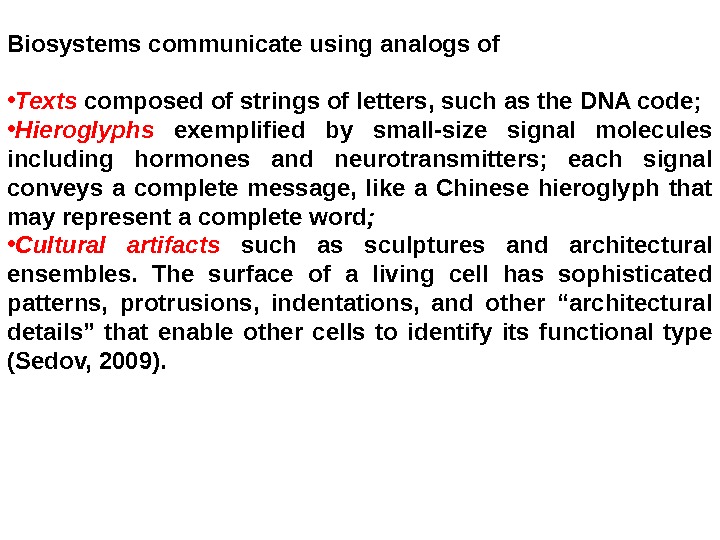
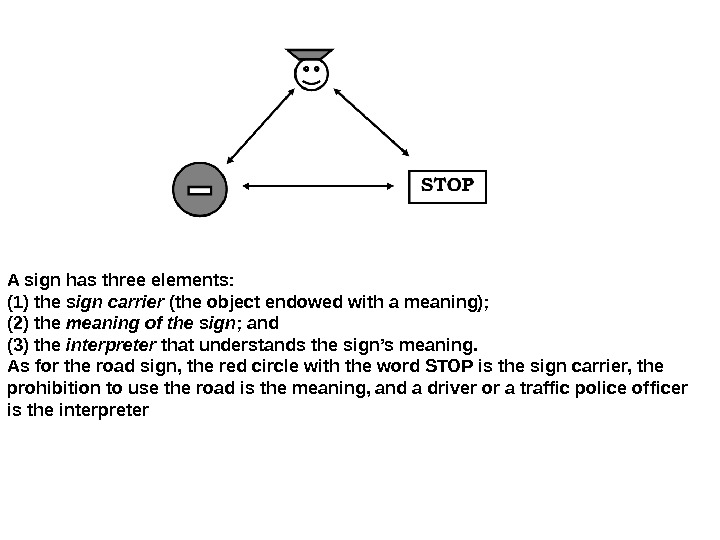
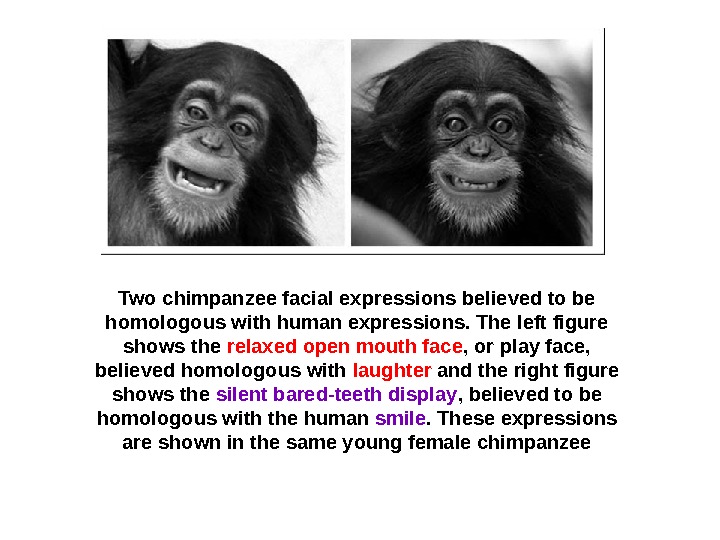
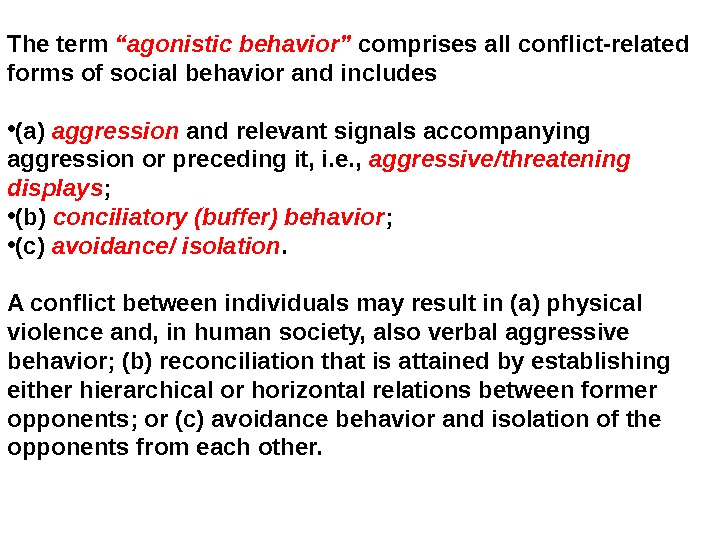
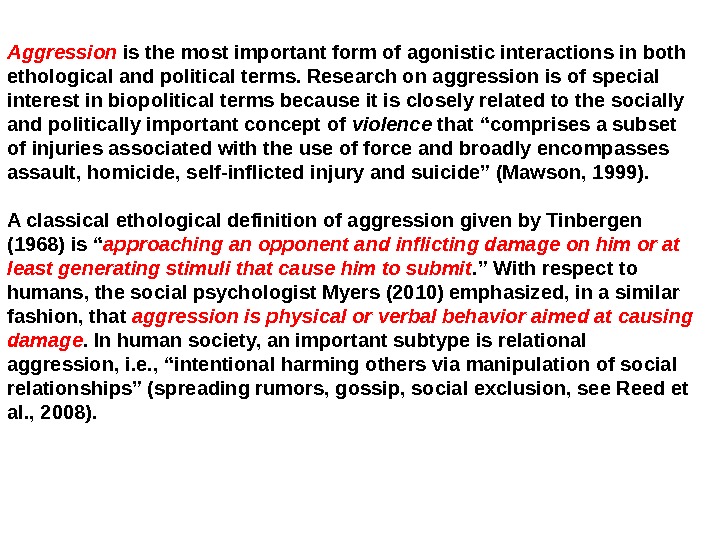
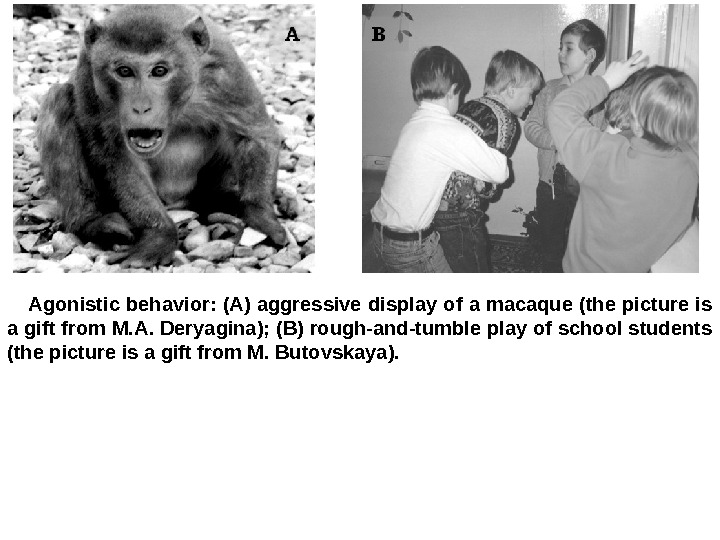
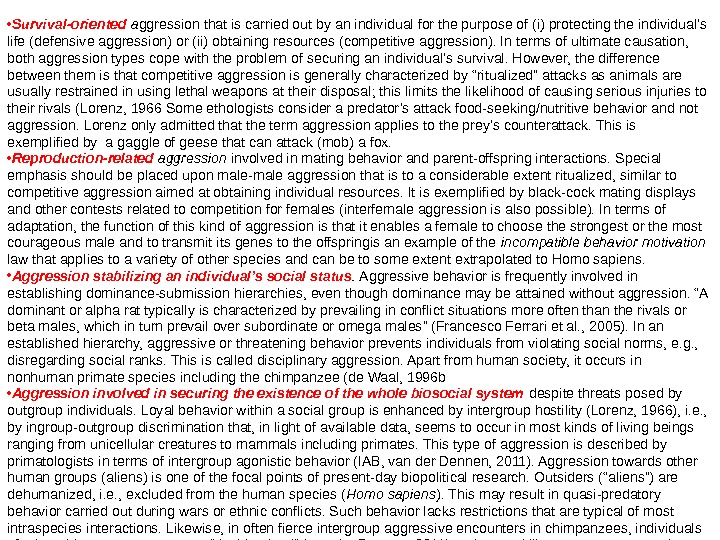
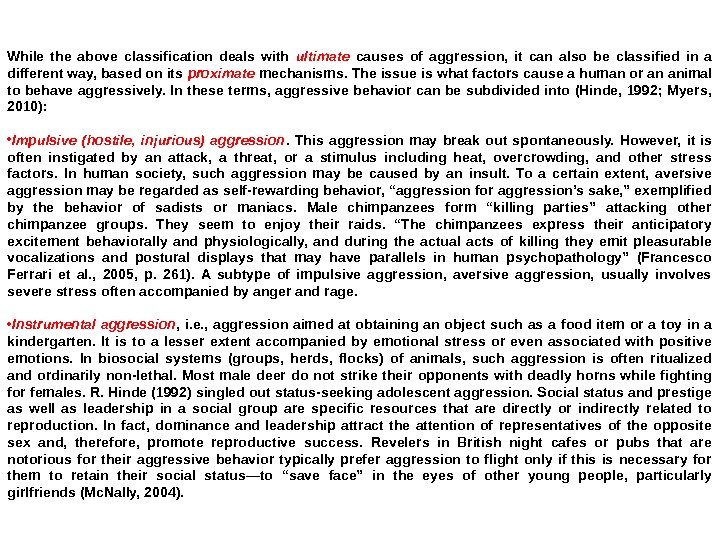
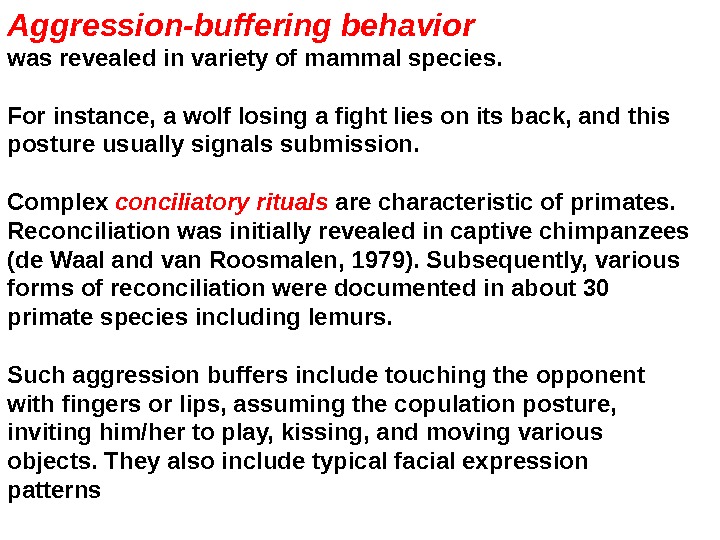
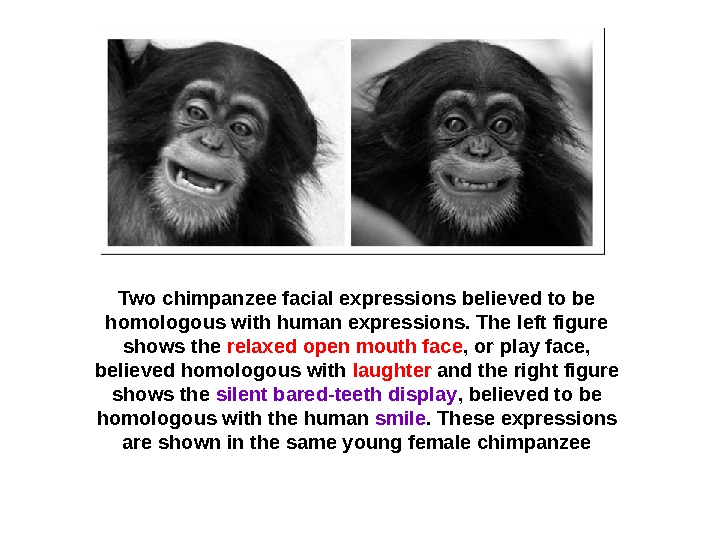
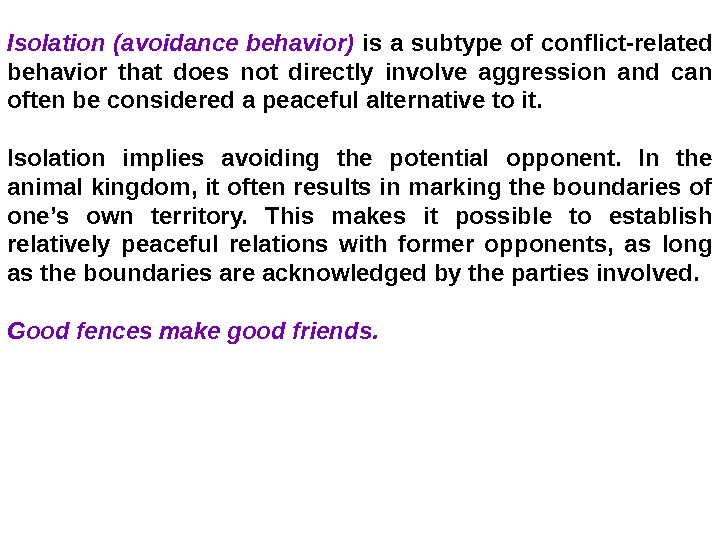

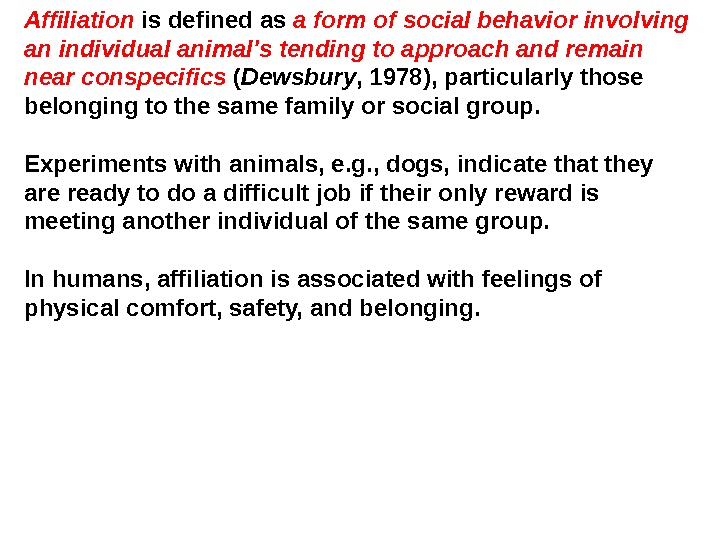
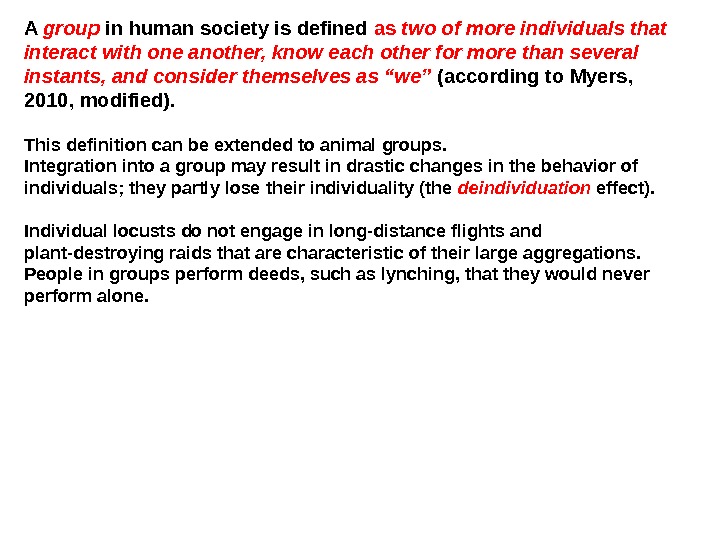
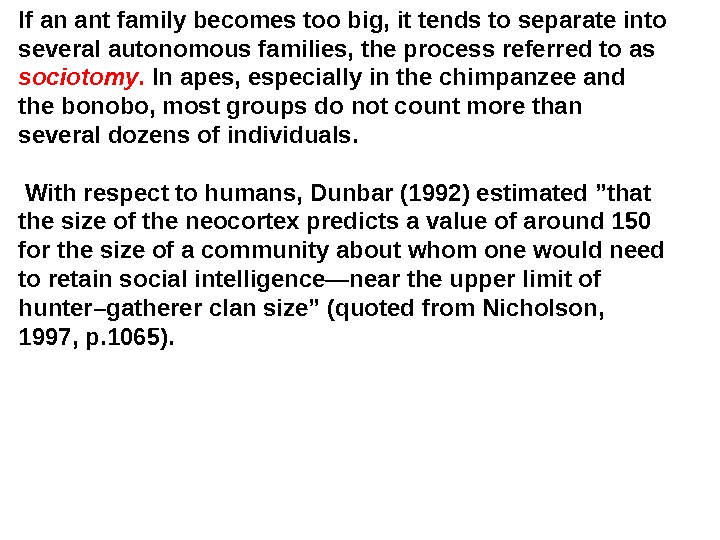
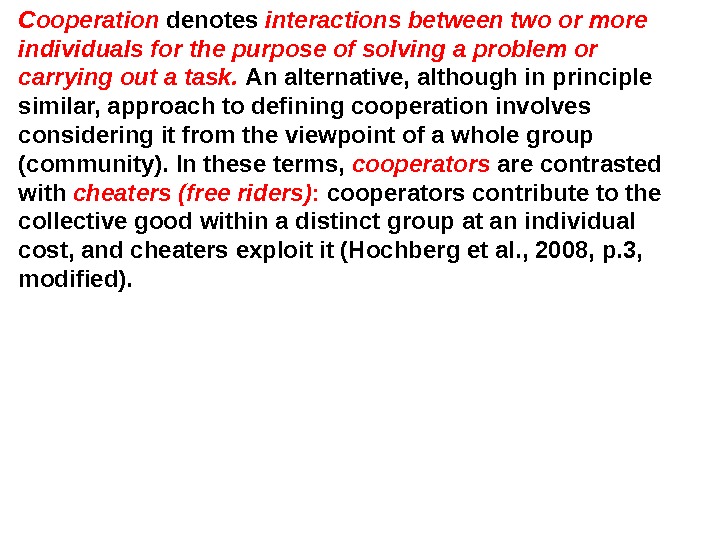
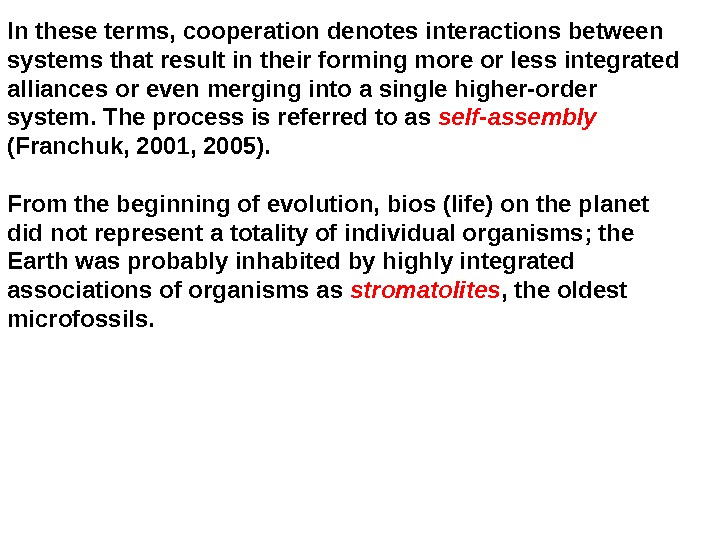
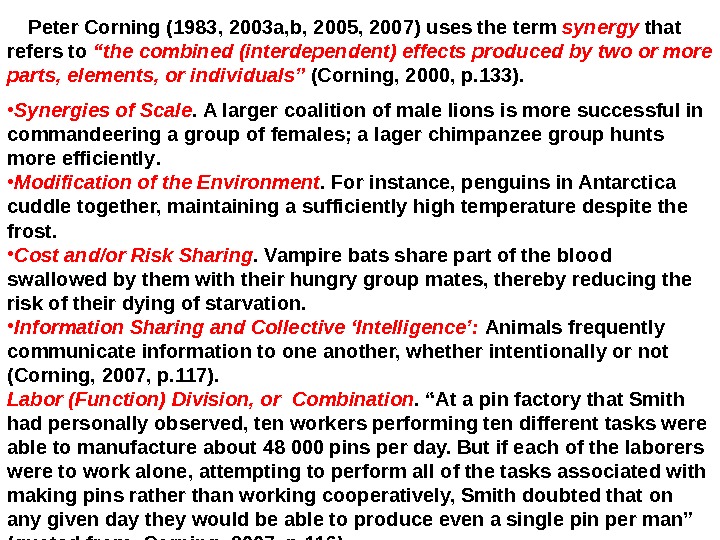
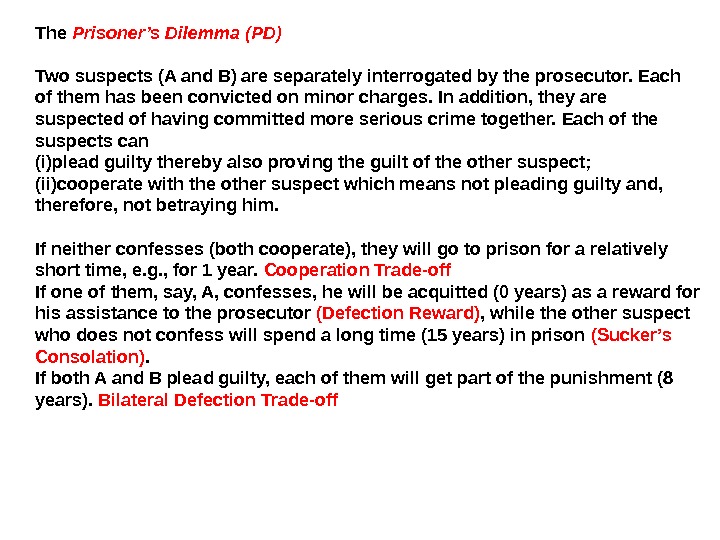
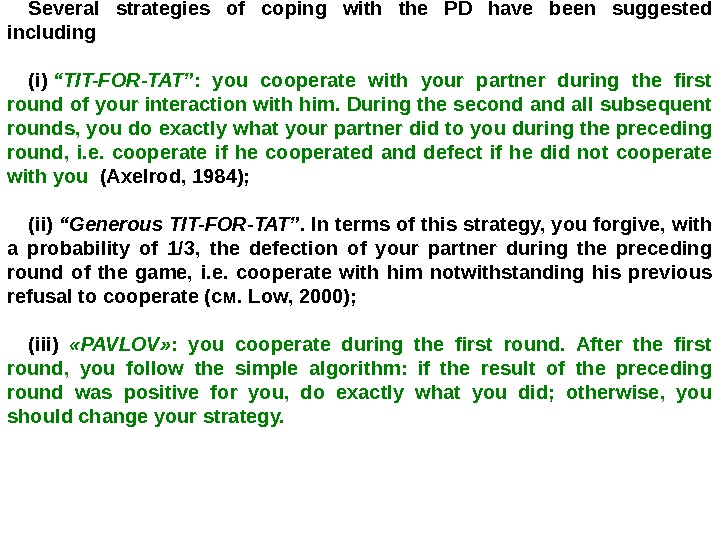
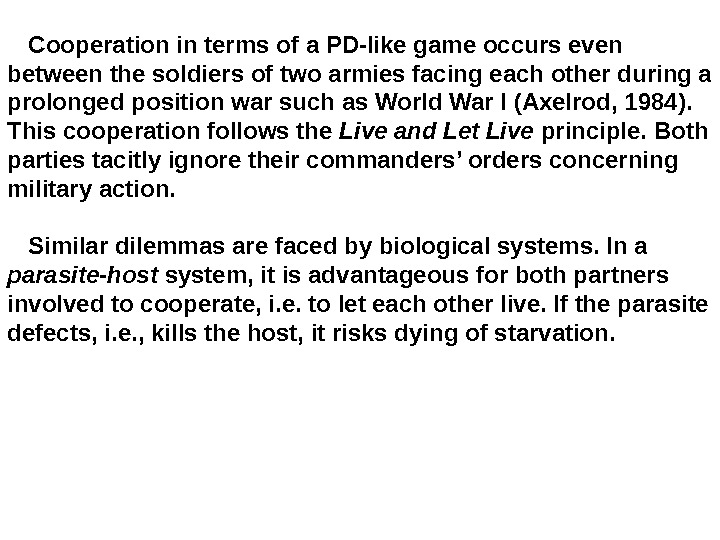

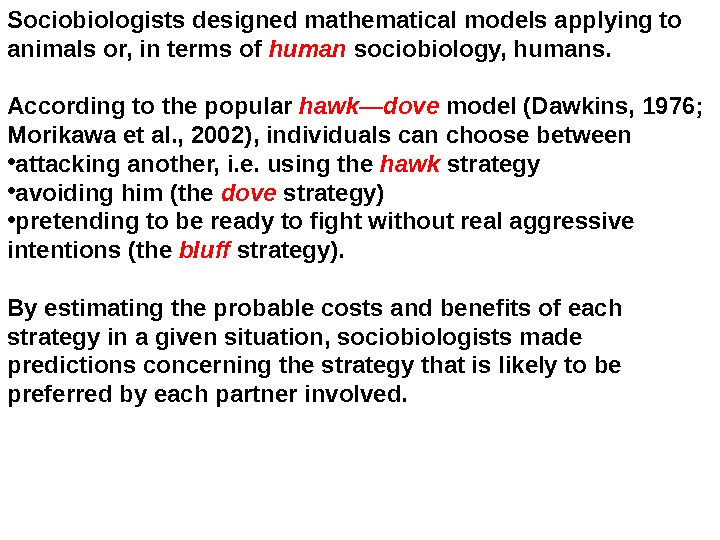
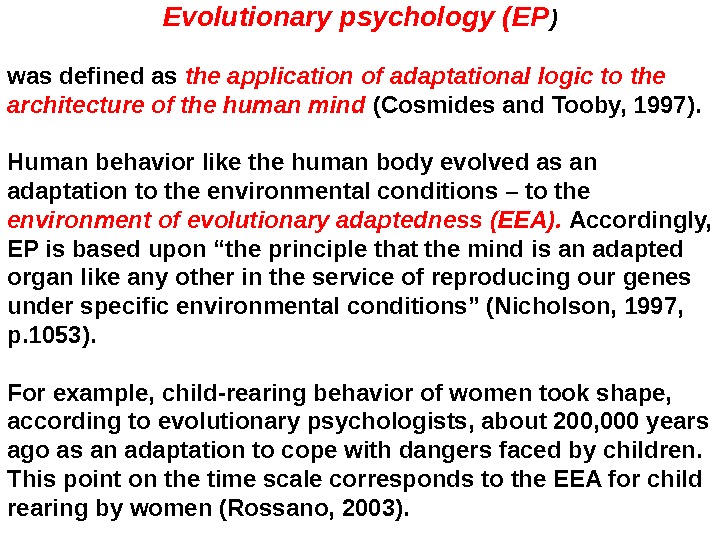
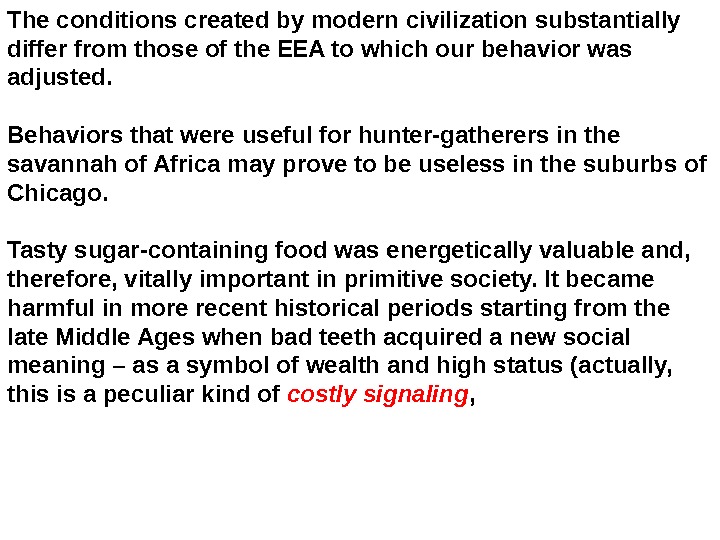
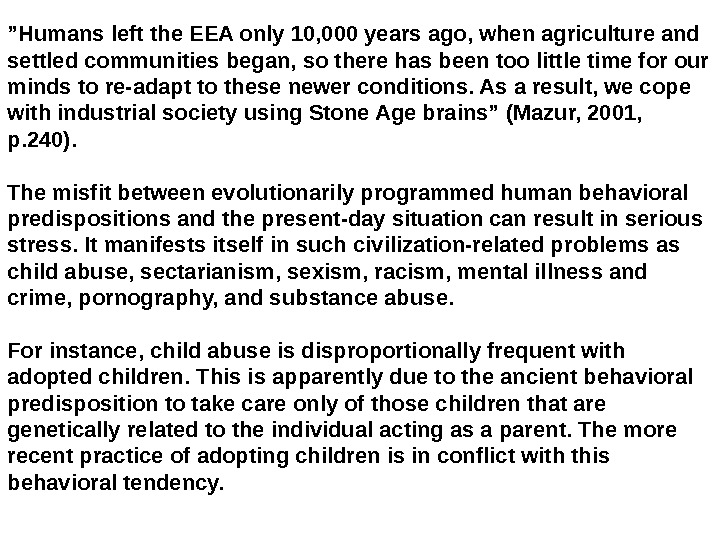
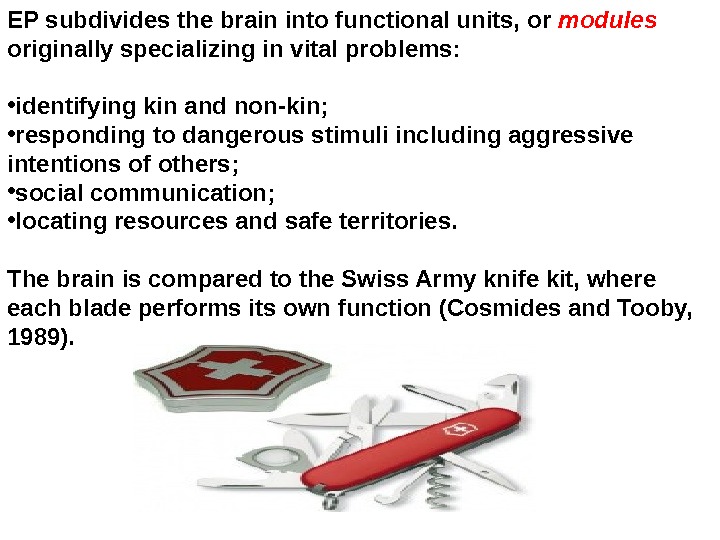
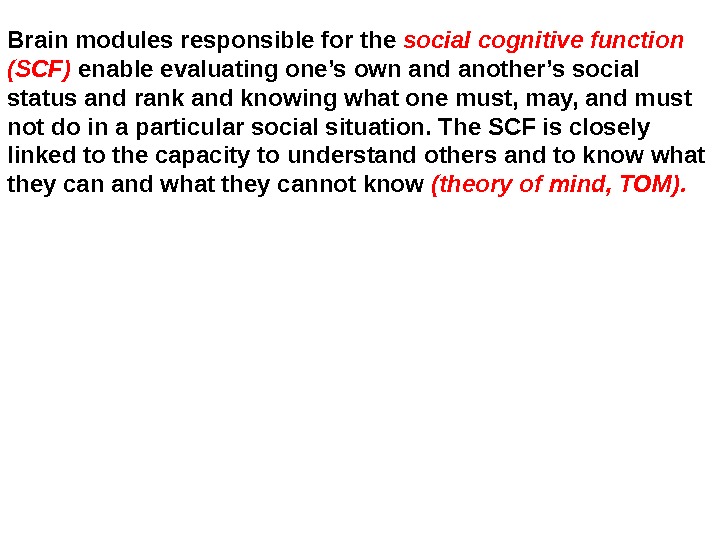
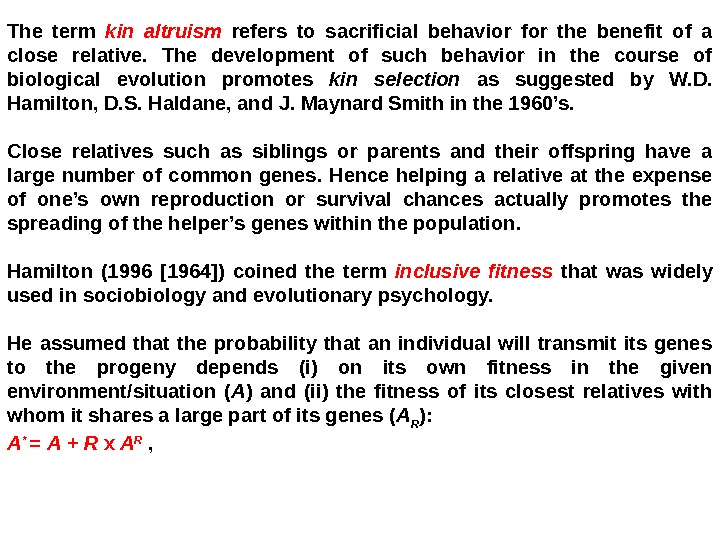

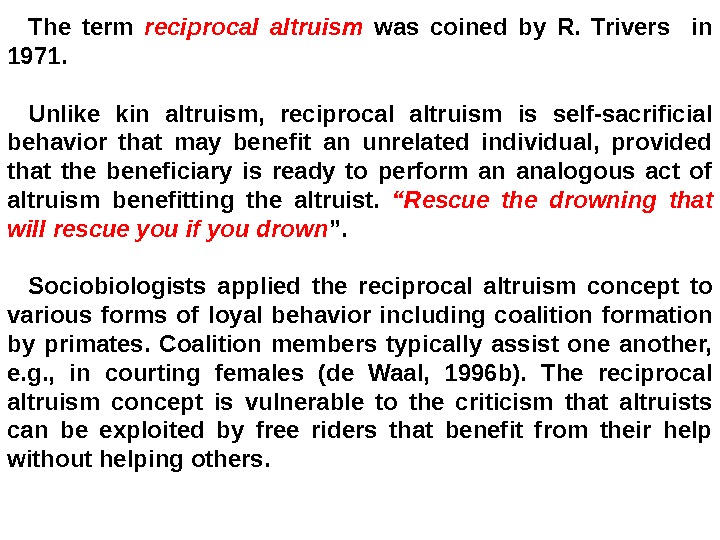
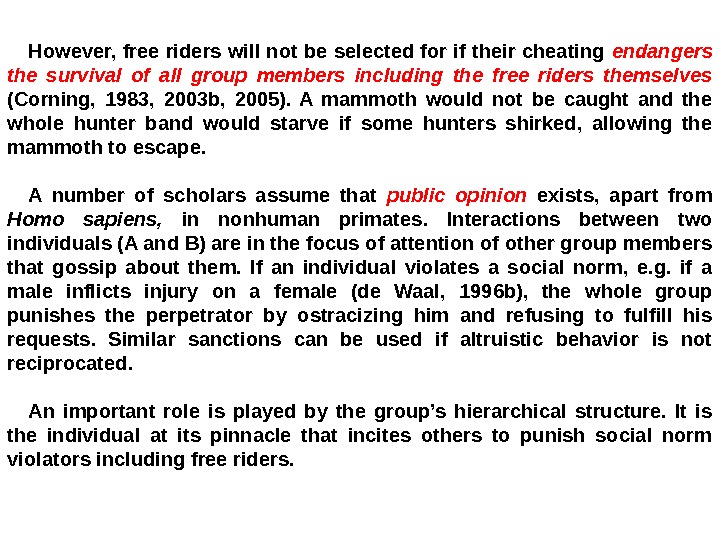
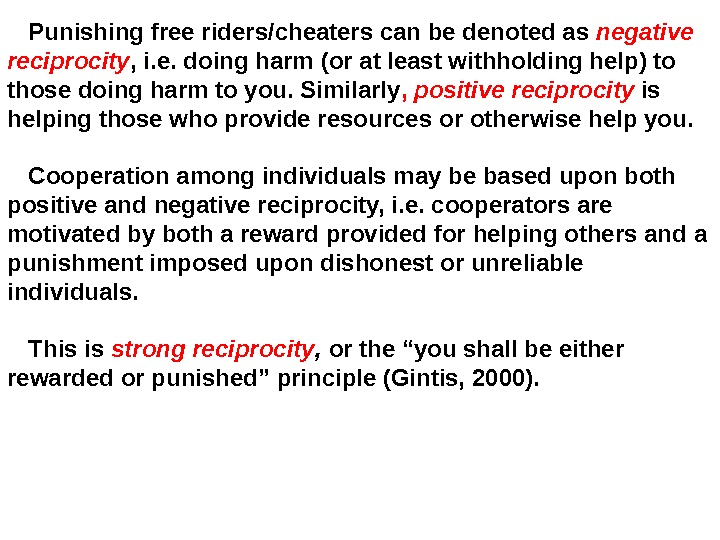
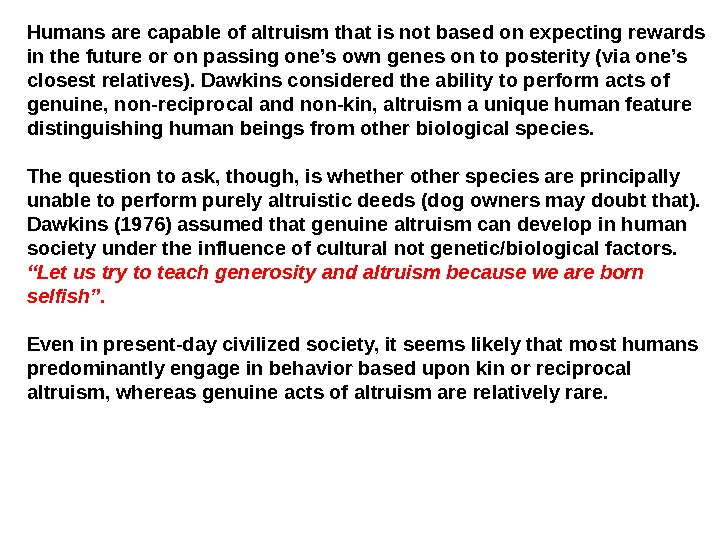

lectures_on_biopolitics_1.ppt
- Размер: 1.8 Mегабайта
- Количество слайдов: 83
Описание презентации BIOPOLITICS The Political Potential of the Life Sciences. по слайдам
 BIOPOLITICS The Political Potential of the Life Sciences. A Course of Lectures (in English) by Prof. Alexander V. Oleskin, General Ecology Dept. , School of Biology, Moscow State Univ.
BIOPOLITICS The Political Potential of the Life Sciences. A Course of Lectures (in English) by Prof. Alexander V. Oleskin, General Ecology Dept. , School of Biology, Moscow State Univ.
 In the most general sense, biopolitics stands for the totality of all kinds of interactions between the life sciences and politics, including both the political potential of biology and the biological implications of politics
In the most general sense, biopolitics stands for the totality of all kinds of interactions between the life sciences and politics, including both the political potential of biology and the biological implications of politics
 • Biopolitics International Organization (B. I. O. ) is located in Athens (Greece). It was founded in 1985 by Agni Vlavianos-Arvanitis. B. I. O. has enrolled representatives from over one hundred countries including Russia. Under its auspices, the International University for the Bio-Environment (I. U. B. E. ) has been established. The organization focuses upon the dimensions of biopolitics (biopolicies) dealing with efforts to protect the manifold of life on the planet, genetic technologies, bioethics, bio-esthetics, and other aspects of the bio-humanit ies. B. I. O. publishes the Bio-News newspaper and distributes it in the electronic form. Its website address is: http: //www. biopolitics. gr
• Biopolitics International Organization (B. I. O. ) is located in Athens (Greece). It was founded in 1985 by Agni Vlavianos-Arvanitis. B. I. O. has enrolled representatives from over one hundred countries including Russia. Under its auspices, the International University for the Bio-Environment (I. U. B. E. ) has been established. The organization focuses upon the dimensions of biopolitics (biopolicies) dealing with efforts to protect the manifold of life on the planet, genetic technologies, bioethics, bio-esthetics, and other aspects of the bio-humanit ies. B. I. O. publishes the Bio-News newspaper and distributes it in the electronic form. Its website address is: http: //www. biopolitics. gr
 Cloned sheep and pigs
Cloned sheep and pigs
 Genetic therapy is curing hereditary diseases by changing the DNA. Genetic therapy applied to practically healthy people becomes genetic enhancement — “making people still better”. Studies with mice models demonstrated that gene insertion could, e. g. , improve their memory.
Genetic therapy is curing hereditary diseases by changing the DNA. Genetic therapy applied to practically healthy people becomes genetic enhancement — “making people still better”. Studies with mice models demonstrated that gene insertion could, e. g. , improve their memory.

 The bio-humanities deal with all possible interactions of the life sciences with social sciences and the humanities , irrespective of their relevance to politics
The bio-humanities deal with all possible interactions of the life sciences with social sciences and the humanities , irrespective of their relevance to politics
 George Bush compared to a chimpanzee (website bushorchimp. org )
George Bush compared to a chimpanzee (website bushorchimp. org )
 According to Foucault, biopolitics is concerned with the effects produced by the political system on the biology of its citizens/subjects. In Foucault’s works, the term “biopolitics” is used as a synonym for another term, “ biopower ” ( le biopouvoir). Biopower exercized by the political system of a state includes regulatory measures aimed at optimizing the biological characteristics and the work capacity of the population or, at least, maintaining them within the normal limits.
According to Foucault, biopolitics is concerned with the effects produced by the political system on the biology of its citizens/subjects. In Foucault’s works, the term “biopolitics” is used as a synonym for another term, “ biopower ” ( le biopouvoir). Biopower exercized by the political system of a state includes regulatory measures aimed at optimizing the biological characteristics and the work capacity of the population or, at least, maintaining them within the normal limits.
 The political systems of Western Europe have, according to Foucault, developed a system of dispositifs , i. e. , practical measures and tools to monitor (using censes and other demographic methods) and control • human reproduction (obstetricians and, more recently, family planning centers), • health and morbidity (health care institutions, sanitation, and hygiene), • work capacity (education, safety regulations, and, much more recently, human engineering), and • mortality (funeral institutions), as well as • the environment.
The political systems of Western Europe have, according to Foucault, developed a system of dispositifs , i. e. , practical measures and tools to monitor (using censes and other demographic methods) and control • human reproduction (obstetricians and, more recently, family planning centers), • health and morbidity (health care institutions, sanitation, and hygiene), • work capacity (education, safety regulations, and, much more recently, human engineering), and • mortality (funeral institutions), as well as • the environment.
 Biopolitics came into being in the late 20 th century as a result of interactions between (i) the life sciences such as • ethology (behavioral research), • theory of evolution, • sociobiology (and, more recently, evolutionary psychology), • genetics, • neurology, and • ecology and (ii) theories in political science based on • behavioralism, • organicism, and/or • synergetics.
Biopolitics came into being in the late 20 th century as a result of interactions between (i) the life sciences such as • ethology (behavioral research), • theory of evolution, • sociobiology (and, more recently, evolutionary psychology), • genetics, • neurology, and • ecology and (ii) theories in political science based on • behavioralism, • organicism, and/or • synergetics.
 Ethology originally emphasized observation of animals in their natural habitats. Through direct observation, ethologists seek to identify rules of behavior vital to the survival and reproductive success of the species under study. Sociobiology developed theoretical models and widely used ethological data in their studies. Generally speaking, sociobiological models were aimed at explaining complex forms of social behavior making good use of concepts borrowed from game theory, decision-making theory as well as economics and other social sciences. For instance, sociobiologists interpreted the behavior of various biological species in terms of cost-benefit analysi s. Evolutionary psychology (EP), a field related to sociobiology with respect to methodology and research goals, was defined as the application of adaptational (i. e. evolutionary – O. A. ) logic to the architecture of the human mind (Cosmides and Tooby, 1997). It is assumed that human behavior like the human body evolved as an adaptation to the environmental conditions of the Pleistocene period when primitive human beings lived – to the environment of evolutionary adaptedness ( EEA ).
Ethology originally emphasized observation of animals in their natural habitats. Through direct observation, ethologists seek to identify rules of behavior vital to the survival and reproductive success of the species under study. Sociobiology developed theoretical models and widely used ethological data in their studies. Generally speaking, sociobiological models were aimed at explaining complex forms of social behavior making good use of concepts borrowed from game theory, decision-making theory as well as economics and other social sciences. For instance, sociobiologists interpreted the behavior of various biological species in terms of cost-benefit analysi s. Evolutionary psychology (EP), a field related to sociobiology with respect to methodology and research goals, was defined as the application of adaptational (i. e. evolutionary – O. A. ) logic to the architecture of the human mind (Cosmides and Tooby, 1997). It is assumed that human behavior like the human body evolved as an adaptation to the environmental conditions of the Pleistocene period when primitive human beings lived – to the environment of evolutionary adaptedness ( EEA ).
 BEHAVIORISM. A behavioral science developed by J. Watson, B. Skinner, and others in the first half of the 20 th century. An organism was compared to a black box, i. e. , an automaton that reacted to a stimulus ( S ) by displaying a stimulus-induced behavioral response ( R ): S → R. BEHAVIOR AL ISM. An approach to behavior that, in contrast to behaviorism, assumes that a stimulus can cause different responses, depending on the state of the organism ( O ) involved. The modified scheme is, therefore, S → O → R. Behavioralism, apart from biological organisms, was applied to social organisms including political bodies.
BEHAVIORISM. A behavioral science developed by J. Watson, B. Skinner, and others in the first half of the 20 th century. An organism was compared to a black box, i. e. , an automaton that reacted to a stimulus ( S ) by displaying a stimulus-induced behavioral response ( R ): S → R. BEHAVIOR AL ISM. An approach to behavior that, in contrast to behaviorism, assumes that a stimulus can cause different responses, depending on the state of the organism ( O ) involved. The modified scheme is, therefore, S → O → R. Behavioralism, apart from biological organisms, was applied to social organisms including political bodies.
 Biopolitics and humanities-centered biology as a whole are actively developed and promoted on the global scale by a number of influential international organizations: • The Association for Politics and Life Sciences (APLS) set up in the 1970 s. Initially, it reflected the attitude of political scientists (A. Somit, S. Peterson, and R. Masters). At present, it deals with an almost complete spectrum of biopolitical subfields that are on the agenda of annual conferences of the Association. Some Association representatives are also members of other biopolitical organization. The Association publishes the journal entitled Politics and the Life Sciences. The website address is: http: //www. hass. us. edu/~apls • The Gruter Institute for Law and Behavioral Research. Founded in 1981. The headquarters are situated in the USA (Portola Valley, CA), and a branch office is in Germany. Directed by Prof Margaret Gruter and Prof. Roger Masters. The organization chiefly deals with the legal and criminal aspects of biopolitics. Emphasis is placed upon physiological (particularly neurological) factors involved in committing crimes, the practical methods of reducing delinquency, and legal issues related to environmental protection. The website address is: http: //www. gruterinstitute. org • The Institute for Studies of Complex Systems (ISCS) founded in 1994 in the USA (Palo-Alto, CA). Headed by Prof. Peter Corning. In terms of systems theory, attempts have been made to conceptualize human beings and human society as the products of the process of “teleonomic evolution” common to all life forms and to develop “ evolutionary/functional approaches to complexity”. The website is http : // www. complexsystems. org.
Biopolitics and humanities-centered biology as a whole are actively developed and promoted on the global scale by a number of influential international organizations: • The Association for Politics and Life Sciences (APLS) set up in the 1970 s. Initially, it reflected the attitude of political scientists (A. Somit, S. Peterson, and R. Masters). At present, it deals with an almost complete spectrum of biopolitical subfields that are on the agenda of annual conferences of the Association. Some Association representatives are also members of other biopolitical organization. The Association publishes the journal entitled Politics and the Life Sciences. The website address is: http: //www. hass. us. edu/~apls • The Gruter Institute for Law and Behavioral Research. Founded in 1981. The headquarters are situated in the USA (Portola Valley, CA), and a branch office is in Germany. Directed by Prof Margaret Gruter and Prof. Roger Masters. The organization chiefly deals with the legal and criminal aspects of biopolitics. Emphasis is placed upon physiological (particularly neurological) factors involved in committing crimes, the practical methods of reducing delinquency, and legal issues related to environmental protection. The website address is: http: //www. gruterinstitute. org • The Institute for Studies of Complex Systems (ISCS) founded in 1994 in the USA (Palo-Alto, CA). Headed by Prof. Peter Corning. In terms of systems theory, attempts have been made to conceptualize human beings and human society as the products of the process of “teleonomic evolution” common to all life forms and to develop “ evolutionary/functional approaches to complexity”. The website is http : // www. complexsystems. org.
 The Club of Biopolitics (CB) was established at Moscow State University under the guidance of the Moscow Society of Natural Scientists. The goals of the Club include designing and implementing an educational strategy aimed at increasing the awareness in the field of biopolitics of various social groups including politicians, business people, educators, doctors, lawyers, and youth activists); developing a coherent system of biological education and conducting discussions on educational issues; and developing and promoting recommendations and suggestions concerning bio- and social technologies aimed at (i) protecting the environment, (ii) improving the physical and mental health as well as the social situation of Russian citizens, (iii) rehabilitating the victims of stress situations including psycho traumas and somatic diseases, (iv) mitigating conflicts on various level of society; (v) promoting mutual understanding between different ethnic and social groups, and (vi) making good use of biopolitical projects such as the creation of non-hierarchical network structures in society. The websites are http: //biopolitika. ru (click: Club of Biopolitics) or http: //moipros. ru.
The Club of Biopolitics (CB) was established at Moscow State University under the guidance of the Moscow Society of Natural Scientists. The goals of the Club include designing and implementing an educational strategy aimed at increasing the awareness in the field of biopolitics of various social groups including politicians, business people, educators, doctors, lawyers, and youth activists); developing a coherent system of biological education and conducting discussions on educational issues; and developing and promoting recommendations and suggestions concerning bio- and social technologies aimed at (i) protecting the environment, (ii) improving the physical and mental health as well as the social situation of Russian citizens, (iii) rehabilitating the victims of stress situations including psycho traumas and somatic diseases, (iv) mitigating conflicts on various level of society; (v) promoting mutual understanding between different ethnic and social groups, and (vi) making good use of biopolitical projects such as the creation of non-hierarchical network structures in society. The websites are http: //biopolitika. ru (click: Club of Biopolitics) or http: //moipros. ru.
 In the most general sense, biopolitics stands for the totality of all kinds of interactions between the life sciences and politics, including both the political potential of biology and the biological implications of politics Biology ↔ Politics B ↔ P
In the most general sense, biopolitics stands for the totality of all kinds of interactions between the life sciences and politics, including both the political potential of biology and the biological implications of politics Biology ↔ Politics B ↔ P
 B → P Biopolitics Of paramount importance in terms of biopolitics is research on universal forms of behavior of human individuals that exist regardless of their culture, ethnicity, and epoch, including • “ the capacity for language, • attraction between the sexes, • the mother-child bond, • facial expressions, and • male cooperation in warfare” (de Waal, 1996 a, p. B 1) They obviously involve not only cultural factors but also our evolutionary legacy.
B → P Biopolitics Of paramount importance in terms of biopolitics is research on universal forms of behavior of human individuals that exist regardless of their culture, ethnicity, and epoch, including • “ the capacity for language, • attraction between the sexes, • the mother-child bond, • facial expressions, and • male cooperation in warfare” (de Waal, 1996 a, p. B 1) They obviously involve not only cultural factors but also our evolutionary legacy.
 Also concerned with the B → P trajectory are scientists that attempt to explore the political consequences of recent genetic, biomedical, or ecological developments. Some scholars (Anderson, 1987; Gerhard, 2001, 2002; Geyer, 2001; Mietzsch, 2002) believed that biopolitics concentrates on “political activities… based on new knowledge in the life sciences” (Gerhard, 2001, S. 859, translated by O. A. ) and paid special attention to genetic technologies, their social implications, and political regulations concerning them. However, if a biopolitician is interested in the employment of genetic technologies by the political system to manipulate citizens’ biology, then this scholar actually switches to the P → B pathway (or combines both kinds of biopolitics in his works).
Also concerned with the B → P trajectory are scientists that attempt to explore the political consequences of recent genetic, biomedical, or ecological developments. Some scholars (Anderson, 1987; Gerhard, 2001, 2002; Geyer, 2001; Mietzsch, 2002) believed that biopolitics concentrates on “political activities… based on new knowledge in the life sciences” (Gerhard, 2001, S. 859, translated by O. A. ) and paid special attention to genetic technologies, their social implications, and political regulations concerning them. However, if a biopolitician is interested in the employment of genetic technologies by the political system to manipulate citizens’ biology, then this scholar actually switches to the P → B pathway (or combines both kinds of biopolitics in his works).
 P → B Biopolitics The biopower , or biopolitics , exercised by the political system of a state includes regulatory measures aimed at optimizing the biological characteristics and the work capacity of the population or, at least, maintaining them within the normal limits. Note: Foucault himself used the words biopower and biopolitics as synonyms. Most of his disciples considered their meaning to be different.
P → B Biopolitics The biopower , or biopolitics , exercised by the political system of a state includes regulatory measures aimed at optimizing the biological characteristics and the work capacity of the population or, at least, maintaining them within the normal limits. Note: Foucault himself used the words biopower and biopolitics as synonyms. Most of his disciples considered their meaning to be different.
 Giorgio Agamben distinguished between bare life and political existence (legal status) , which correspond to the Greek terms ή and ί ς , respectively.
Giorgio Agamben distinguished between bare life and political existence (legal status) , which correspond to the Greek terms ή and ί ς , respectively.
 Importantly, the biopower exerts influence on ordinary citizens like you and me at five different levels: • Biobehavioral typified by using primate-style dominance cues or coalition-forming behavior for political purposes such as gaining support with potential electors • Genetic which implicates modifying the genome of our offspring in order, e. g. , to make them more obedient, obese (“chubby”), docile, and law-abiding • Neurochemical such as using chemicals for instigating people to become brave soldiers on ther battle field • Microbiological : putting neuromediator-producing bugs into your guts for the purpose of making you work hard and keep smiling all the time • Ecological : modifying the environment in order to change our behavior: exemplified by spreading heavy metal compounds in the atmosphere, which makes people more aggressive and impulsive
Importantly, the biopower exerts influence on ordinary citizens like you and me at five different levels: • Biobehavioral typified by using primate-style dominance cues or coalition-forming behavior for political purposes such as gaining support with potential electors • Genetic which implicates modifying the genome of our offspring in order, e. g. , to make them more obedient, obese (“chubby”), docile, and law-abiding • Neurochemical such as using chemicals for instigating people to become brave soldiers on ther battle field • Microbiological : putting neuromediator-producing bugs into your guts for the purpose of making you work hard and keep smiling all the time • Ecological : modifying the environment in order to change our behavior: exemplified by spreading heavy metal compounds in the atmosphere, which makes people more aggressive and impulsive
 Dominant and submissive behavior in the chimpanzee; a model used by politicians Coalition formation and relevant nonverbal cues in the chimpanzee
Dominant and submissive behavior in the chimpanzee; a model used by politicians Coalition formation and relevant nonverbal cues in the chimpanzee
 The main stages of inserting a new gene into the DNA. The annular DNA molecule of a vector (a plasmide or a bacteriophage) is incised with a restrictase (“molecular scissors”). The DNA becomes linear. The gene of interest is attached to both ends of the linear DNA with a DNA ligase (“molecular glue”). The DNA molecule forms a ring again, but it is enriched with a new gene
The main stages of inserting a new gene into the DNA. The annular DNA molecule of a vector (a plasmide or a bacteriophage) is incised with a restrictase (“molecular scissors”). The DNA becomes linear. The gene of interest is attached to both ends of the linear DNA with a DNA ligase (“molecular glue”). The DNA molecule forms a ring again, but it is enriched with a new gene
 An eco-beach, part of an ecopolis. According to: Dmitri Kavtaradze et al. , 2002. “A minimal number of paths should be used. One path is used by vehicles. . . another, running along the beach, by walkers. Short paths run between the vehicle path and the clearings where the tents are located. . . There are paths between each clearing and the waterfront” (Kavtaradze et al. , 2002, p. 34). Designations: 1, recreation area; 2, botanical sanctuary.
An eco-beach, part of an ecopolis. According to: Dmitri Kavtaradze et al. , 2002. “A minimal number of paths should be used. One path is used by vehicles. . . another, running along the beach, by walkers. Short paths run between the vehicle path and the clearings where the tents are located. . . There are paths between each clearing and the waterfront” (Kavtaradze et al. , 2002, p. 34). Designations: 1, recreation area; 2, botanical sanctuary.
 The Foucauldian concepts of biopolitics and biopower were modified by Maurizio Lazzarato, Antonio Negri, Michael Hardt, and others. Unlike Foucault, these scholars did not regard these two terms as synonyms. In their opinion, the control exercised by the state political system over the biology of the citizens/subjects—a “form of power that regulates social life from its interior, following it, interpreting it, absorbing it, and rearticulating it”—is to be denoted as biopower (Hardt & Negri, 2000, p. 23). As for biopolitics , it primarily refers to resistance to biopower, a vivid and creative force that biopower tries to harness. This resistance on the political front—biopolitics sensu Hardt & Negri—is exemplified by movements organized by homosexuals, lesbians, blacks’ rights activists, and the disabled.
The Foucauldian concepts of biopolitics and biopower were modified by Maurizio Lazzarato, Antonio Negri, Michael Hardt, and others. Unlike Foucault, these scholars did not regard these two terms as synonyms. In their opinion, the control exercised by the state political system over the biology of the citizens/subjects—a “form of power that regulates social life from its interior, following it, interpreting it, absorbing it, and rearticulating it”—is to be denoted as biopower (Hardt & Negri, 2000, p. 23). As for biopolitics , it primarily refers to resistance to biopower, a vivid and creative force that biopower tries to harness. This resistance on the political front—biopolitics sensu Hardt & Negri—is exemplified by movements organized by homosexuals, lesbians, blacks’ rights activists, and the disabled.
 In the three recent books of Michael Hardt and Antonio Negri about “the Empire, ” biopolitics is construed to comprise anti-capitalist political activities. The human body is considered a weapon in this political struggle, which, “in its most tragic and revolting form, ” includes suicidal terrorism (Hardt and Negri, 2005).
In the three recent books of Michael Hardt and Antonio Negri about “the Empire, ” biopolitics is construed to comprise anti-capitalist political activities. The human body is considered a weapon in this political struggle, which, “in its most tragic and revolting form, ” includes suicidal terrorism (Hardt and Negri, 2005).
 Biopolitics is applied to three different levels: • Social philosophy as related to politics • Political science (including political philosophy as its subfield) • Practical policy issues.
Biopolitics is applied to three different levels: • Social philosophy as related to politics • Political science (including political philosophy as its subfield) • Practical policy issues.
 Biopolitics addresses the following issues related to social, and in particular political, philosophy (see Masters, 1989; Blank & Hines, 2001; Somit & Peterson, 1998, 2001 a): • the nature of man (whether man is intrinsically good or evil, altruistic or self-centered, his nature is fixed or malleable, he is born with some innate ideas and concepts concerning the world, human society, ethics, and language—or is just a tabula rasa; whether we are rational or driven by emotions); • the origin and purposes of politics and the state, starting from precursors of political systems in primitive human societies or even social groups of apes; The primary goal of each political system including an ape group is just survival. • the nature of political obligation; what law-abiding citizens must or must not do • the problem of creating and maintaining political order. Of relevance is the fact that nonhuman primates form both hierarchical and horizontal (egalitarian) structures; political systems use modified versions of both kinds of structures, and the proportion between them varies depending on the political regime; • “ the vision of the ideal—or best possible—state” (Somit & Peterson, 2001 a, p. 189).
Biopolitics addresses the following issues related to social, and in particular political, philosophy (see Masters, 1989; Blank & Hines, 2001; Somit & Peterson, 1998, 2001 a): • the nature of man (whether man is intrinsically good or evil, altruistic or self-centered, his nature is fixed or malleable, he is born with some innate ideas and concepts concerning the world, human society, ethics, and language—or is just a tabula rasa; whether we are rational or driven by emotions); • the origin and purposes of politics and the state, starting from precursors of political systems in primitive human societies or even social groups of apes; The primary goal of each political system including an ape group is just survival. • the nature of political obligation; what law-abiding citizens must or must not do • the problem of creating and maintaining political order. Of relevance is the fact that nonhuman primates form both hierarchical and horizontal (egalitarian) structures; political systems use modified versions of both kinds of structures, and the proportion between them varies depending on the political regime; • “ the vision of the ideal—or best possible—state” (Somit & Peterson, 2001 a, p. 189).
 A distinction between physical (mechanistic ) and biological naturalism can be made. Biological naturalism focuses on b iology for understanding human behavior, psychology, and social organization. Thomas Thorson, the author of the first book entitled Biopolitics , contrasted the attitude of biological naturalism with that of physical naturalism: “ Does it make more sense to understand man as a biological phenomenon with all that implies, or to try to fit human behavior to the prediction-generalization model of nineteenth-century physics? When the question is put this way, the proper answer is, I trust, so obvious that it requires no discussion” (Thorson, 1970, p. 96).
A distinction between physical (mechanistic ) and biological naturalism can be made. Biological naturalism focuses on b iology for understanding human behavior, psychology, and social organization. Thomas Thorson, the author of the first book entitled Biopolitics , contrasted the attitude of biological naturalism with that of physical naturalism: “ Does it make more sense to understand man as a biological phenomenon with all that implies, or to try to fit human behavior to the prediction-generalization model of nineteenth-century physics? When the question is put this way, the proper answer is, I trust, so obvious that it requires no discussion” (Thorson, 1970, p. 96).
 Hard naturalism. This philosophical paradigm existed long before the emergence of biopolitics and before the publishing of the first book on this subject by Morley Roberts in 1938. A notorious example was Social Darwinism promoted at the turn of the 20 th century. Hard naturalism of this kind actually equated humans and animals, considering them all ruthless competitors, “red in tooth and claw” in Thomas Huxley’s words. In the popular books of the 1960 s published by K. Lorenz ( Aggression ), R. Adrey ( Territorial Imperative ), and D. Morris ( Human Zoo, The Naked Ape ). “The Naked Ape” ( Homo sapiens ) was straightforwardly compared to other primates, the work done by civilized humans, to the collective hunting of primate males, and the wages to the “spoils” (to be shared with the female). The other extreme attitude was based upon the assumption that biological species (“the organic”) are principally incomparable to human beings (whose culture was regarded as “superorganic” by A. Kroeber). The predominant trend in the humanities and social sciences in the 20 th century was to consider the human being just “a disembodied mind. ” In contrast to both hard naturalism and the opposite purely social attitude toward the human being, most biopoliticians prefer the middle-ground position based upon soft naturalism. Although a product of biological evolution that has undoubtedly left its marks on his behavior, Homo sapiens also possesses unique features that distinguish him from all other creatures including other higher primates (“The Big Apes”).
Hard naturalism. This philosophical paradigm existed long before the emergence of biopolitics and before the publishing of the first book on this subject by Morley Roberts in 1938. A notorious example was Social Darwinism promoted at the turn of the 20 th century. Hard naturalism of this kind actually equated humans and animals, considering them all ruthless competitors, “red in tooth and claw” in Thomas Huxley’s words. In the popular books of the 1960 s published by K. Lorenz ( Aggression ), R. Adrey ( Territorial Imperative ), and D. Morris ( Human Zoo, The Naked Ape ). “The Naked Ape” ( Homo sapiens ) was straightforwardly compared to other primates, the work done by civilized humans, to the collective hunting of primate males, and the wages to the “spoils” (to be shared with the female). The other extreme attitude was based upon the assumption that biological species (“the organic”) are principally incomparable to human beings (whose culture was regarded as “superorganic” by A. Kroeber). The predominant trend in the humanities and social sciences in the 20 th century was to consider the human being just “a disembodied mind. ” In contrast to both hard naturalism and the opposite purely social attitude toward the human being, most biopoliticians prefer the middle-ground position based upon soft naturalism. Although a product of biological evolution that has undoubtedly left its marks on his behavior, Homo sapiens also possesses unique features that distinguish him from all other creatures including other higher primates (“The Big Apes”).
 Presently, biopolitics adopts the idea that the human being is a multilevel system. Despite the indisputably important biological (biobehavioral) level that produces an effect on human psyche and social behavior, this multilevel system also includes a whole complex of social/cultural levels. They exert a strong influence on social behavior and political activities, as well as on the biological level itself (this is the P → B variant of biopolitics described in Foucault’s writings and in recent works on genetic engineering as applied to the human genome). Taking into account the multilevel organization of the human being, biologists should work in collaboration with social scientists to adequately interpret political phenomena. Biopoliticians advocating soft naturalism acknowledge the unique status of the human being that is endowed with reason, articulate speech and symbolic language, culture, and technology. They do not believe in Social Darwinism and reject hard naturalism. However, they assume that human nature includes a biological component. The present-day life sciences provide us with important information concerning the role of this component of human nature in terms of human social behavior, basic needs, and political activities. “ We have an innate behavioral repertoire that can be used to qualify human beings as social animals” (Masters, 1989, p. 68).
Presently, biopolitics adopts the idea that the human being is a multilevel system. Despite the indisputably important biological (biobehavioral) level that produces an effect on human psyche and social behavior, this multilevel system also includes a whole complex of social/cultural levels. They exert a strong influence on social behavior and political activities, as well as on the biological level itself (this is the P → B variant of biopolitics described in Foucault’s writings and in recent works on genetic engineering as applied to the human genome). Taking into account the multilevel organization of the human being, biologists should work in collaboration with social scientists to adequately interpret political phenomena. Biopoliticians advocating soft naturalism acknowledge the unique status of the human being that is endowed with reason, articulate speech and symbolic language, culture, and technology. They do not believe in Social Darwinism and reject hard naturalism. However, they assume that human nature includes a biological component. The present-day life sciences provide us with important information concerning the role of this component of human nature in terms of human social behavior, basic needs, and political activities. “ We have an innate behavioral repertoire that can be used to qualify human beings as social animals” (Masters, 1989, p. 68).
 The applications of biopolitics at the political-science and at the practical-policy level are ultimately based upon its social-philosophy level. Naturalism that provides the philosophical foundations for biopolitics is closely linked to two practically important attitudes—a positive and a negative—towards the biological element/level of human nature. Though apparently diametrically opposite, these attitudes are actually complementary to one another and should be reasonably combined in practice: Attitude 1. Knowledge concerning evolutionarily conserved (primitive, primate-specific) behavioral trends in humans can be creatively used to develop effective social technologies, exemplified by the network structures-promoting project The biological element of human nature holds, therefore, much potential practical value. A highly debatable point is to what extent it is justifiable to consider ethical/moral norms of human society from the evolutionary perspective and to envisage them (norms) as concordant with evolution-shaped behavior tendencies aimed at securing the survival of the biological species Homo sapiens. Attitude 2. Biopolitical data regarding human behavior enables us to overcome primitive behavioral trends that can cause negative consequences or result in immoral actions unless put under contro l. R. Masters and B. Way (1996, p. 89) emphasize that “it is experimental research in biopolitics that shows us most clearly the danger that human language and reason will be overshadowed by feelings elicited by nonverbal cues we share with nonhuman primates. ”
The applications of biopolitics at the political-science and at the practical-policy level are ultimately based upon its social-philosophy level. Naturalism that provides the philosophical foundations for biopolitics is closely linked to two practically important attitudes—a positive and a negative—towards the biological element/level of human nature. Though apparently diametrically opposite, these attitudes are actually complementary to one another and should be reasonably combined in practice: Attitude 1. Knowledge concerning evolutionarily conserved (primitive, primate-specific) behavioral trends in humans can be creatively used to develop effective social technologies, exemplified by the network structures-promoting project The biological element of human nature holds, therefore, much potential practical value. A highly debatable point is to what extent it is justifiable to consider ethical/moral norms of human society from the evolutionary perspective and to envisage them (norms) as concordant with evolution-shaped behavior tendencies aimed at securing the survival of the biological species Homo sapiens. Attitude 2. Biopolitical data regarding human behavior enables us to overcome primitive behavioral trends that can cause negative consequences or result in immoral actions unless put under contro l. R. Masters and B. Way (1996, p. 89) emphasize that “it is experimental research in biopolitics that shows us most clearly the danger that human language and reason will be overshadowed by feelings elicited by nonverbal cues we share with nonhuman primates. ”
 Many primitive forms of human behavior are envisaged in terms of evolutionary psychology , a field related to biopolitics, as adaptations to the environmental conditions of the Pleistocene period. These behaviors may be maladaptive in the present-day civilized world. Evolution has endowed us with potentially conflicting behavioral predispositions whose reasonable, situation-dependent, balance is vital for the species’ survival
Many primitive forms of human behavior are envisaged in terms of evolutionary psychology , a field related to biopolitics, as adaptations to the environmental conditions of the Pleistocene period. These behaviors may be maladaptive in the present-day civilized world. Evolution has endowed us with potentially conflicting behavioral predispositions whose reasonable, situation-dependent, balance is vital for the species’ survival
 Biological naturalism underlying biopolitics is in conformity with the worldview and the value system that is based upon biocentrism (Greek: ί ς, life; έ center). From the biocentric viewpoint, humankind is to be considered part of life (bios) as a coherent global entity. Biocentrism is opposed to anthropocentrism (Greek: ΄ά ς, human). Anthropocentrism has been characteristic of the European mentality, starting from the Middle Ages. Originally, it took the form of religious (theological) anthropocentrism that was partly replaced by secular anthropocentrism during the Modern Age. Anthropocentrists believe in the supremacy of humankind on the planet and grant exclusive privileges and rights to humans. All other life forms on the Earth are regarded as resources to be exploited by humans.
Biological naturalism underlying biopolitics is in conformity with the worldview and the value system that is based upon biocentrism (Greek: ί ς, life; έ center). From the biocentric viewpoint, humankind is to be considered part of life (bios) as a coherent global entity. Biocentrism is opposed to anthropocentrism (Greek: ΄ά ς, human). Anthropocentrism has been characteristic of the European mentality, starting from the Middle Ages. Originally, it took the form of religious (theological) anthropocentrism that was partly replaced by secular anthropocentrism during the Modern Age. Anthropocentrists believe in the supremacy of humankind on the planet and grant exclusive privileges and rights to humans. All other life forms on the Earth are regarded as resources to be exploited by humans.
 The main message given by biopolitics is that life is a global coherent entity, despite the diversity of biological species. Life is based on the unity-in-diversity principle. The biosphere as a global system is capable of regulating the Earth’s characteristics including its temperature, albedo, and atmosphere composition, in the interest of biological evolution and the flourishing of the whole gamut of living beings on the Earth. This is the central idea of the sufficiently well-grounded Gaia theory suggested by John Lovelock (1979, 1983). The diversity of ethnicities, nations, religions should be regarded as an analog of the planet’s biodiversity that does not downplay—and rather highlights—the importance of the unity of bios and the interdependence of all living beings on the Earth. Biopolitics persuades political scientists to regard the ethnic, religious, and regional diversity of humankind as its advantage, rather than merely a source of political conflict.
The main message given by biopolitics is that life is a global coherent entity, despite the diversity of biological species. Life is based on the unity-in-diversity principle. The biosphere as a global system is capable of regulating the Earth’s characteristics including its temperature, albedo, and atmosphere composition, in the interest of biological evolution and the flourishing of the whole gamut of living beings on the Earth. This is the central idea of the sufficiently well-grounded Gaia theory suggested by John Lovelock (1979, 1983). The diversity of ethnicities, nations, religions should be regarded as an analog of the planet’s biodiversity that does not downplay—and rather highlights—the importance of the unity of bios and the interdependence of all living beings on the Earth. Biopolitics persuades political scientists to regard the ethnic, religious, and regional diversity of humankind as its advantage, rather than merely a source of political conflict.
 The history of biopolitics in the 20 th and the 21 st century was preceded by the long period of the development of the science dealing with life. The term biology was coined by Lamarck in France and independently by Treviranus in Germany at the beginning of the 19 th century. In philosophical terms, the central issue of biopolitics (as well as other subfields of the bio-humanities) was dealt with by biology over the whole course of its historical development. This issue is concerned with humankind’s place in the biosphere and includes two main aspects: • The comparability of humans and other forms of life , primarily in terms of behavior, communication, and social organization as related to politics • The attitude toward planetary life that manifests itself in practical policies concerning the biosphere as well as human biology. The question to ask is whether people should protect the biosphere, show “reverence for life” (according to Albert Schweitzer), or exploit it—or even destroy some of its parts —in the interest of humankind. The second aspect can be subdivided into two parts, depending on whether we have in mind (2 a) the actual and (2 b) the desirable attitude and policy of humankind concerning life including both the species Homo sapiens and the whole biodiversity of the planet.
The history of biopolitics in the 20 th and the 21 st century was preceded by the long period of the development of the science dealing with life. The term biology was coined by Lamarck in France and independently by Treviranus in Germany at the beginning of the 19 th century. In philosophical terms, the central issue of biopolitics (as well as other subfields of the bio-humanities) was dealt with by biology over the whole course of its historical development. This issue is concerned with humankind’s place in the biosphere and includes two main aspects: • The comparability of humans and other forms of life , primarily in terms of behavior, communication, and social organization as related to politics • The attitude toward planetary life that manifests itself in practical policies concerning the biosphere as well as human biology. The question to ask is whether people should protect the biosphere, show “reverence for life” (according to Albert Schweitzer), or exploit it—or even destroy some of its parts —in the interest of humankind. The second aspect can be subdivided into two parts, depending on whether we have in mind (2 a) the actual and (2 b) the desirable attitude and policy of humankind concerning life including both the species Homo sapiens and the whole biodiversity of the planet.
 The main paradigms (systems of ideas) in the history of biology that prepared the ground for biopolitics; 1. Mythological Paradigm Primitive Society 2. Natural-Philosophy Paradigm 2 nd Millennium BC– 18 th c. AD 3. Theological Paradigm 3 rd c. AD — present 4. Mechanistic Paradigm 16 -19 c. 5. Evolutionary Paradigm 19 — present 6. Social Paradigm 20 c/ — present
The main paradigms (systems of ideas) in the history of biology that prepared the ground for biopolitics; 1. Mythological Paradigm Primitive Society 2. Natural-Philosophy Paradigm 2 nd Millennium BC– 18 th c. AD 3. Theological Paradigm 3 rd c. AD — present 4. Mechanistic Paradigm 16 -19 c. 5. Evolutionary Paradigm 19 — present 6. Social Paradigm 20 c/ — present
 Biomorphic arts: a Cretan Vase with an octopus image, originated from the middle of the second millennium B. C.
Biomorphic arts: a Cretan Vase with an octopus image, originated from the middle of the second millennium B. C.
 (A) Normal cells obey the social rule known as contact inhibition: they do not reproduce if there is not enough room for new cells. If a part of the cells growing as a momolayer culture on a petri dish is removed with a blade, the resulting cell-free zone will be occupied by new cells that result from the division of the cells located near the gap. (B) Tumor cells violate “social norms. ” They divide despite a lack of cell-free area around them, covering each other or normal adjacent cells.
(A) Normal cells obey the social rule known as contact inhibition: they do not reproduce if there is not enough room for new cells. If a part of the cells growing as a momolayer culture on a petri dish is removed with a blade, the resulting cell-free zone will be occupied by new cells that result from the division of the cells located near the gap. (B) Tumor cells violate “social norms. ” They divide despite a lack of cell-free area around them, covering each other or normal adjacent cells.
 Ethology originally emphasized observation of animals in their natural habitats. Through direct observation, ethologists seek to identify rules of behavior vital to the survival and reproductive success of the species under study. ULTIMATE AND PROXIMATE CAUSES OF BEHAVIOR • The physiological mechanisms that carry out behavior, involving the animal’s sense organs and the nervous system = proximate mechanisms. For instance, we can measure hormone levels or record impulses on nervous cells during the behavior under study (e. g. , aggression of a vervet monkey male directed at a conspecific). • The question how a particular kind of behavior developed in evolution, why it was selected, and what its adaptive value was, relates to the ultimate causes of the behavior. They can be elucidated by, e. g. , investigating the behavior’s influence on survival or reproductive success (i. e. , number of offspring).
Ethology originally emphasized observation of animals in their natural habitats. Through direct observation, ethologists seek to identify rules of behavior vital to the survival and reproductive success of the species under study. ULTIMATE AND PROXIMATE CAUSES OF BEHAVIOR • The physiological mechanisms that carry out behavior, involving the animal’s sense organs and the nervous system = proximate mechanisms. For instance, we can measure hormone levels or record impulses on nervous cells during the behavior under study (e. g. , aggression of a vervet monkey male directed at a conspecific). • The question how a particular kind of behavior developed in evolution, why it was selected, and what its adaptive value was, relates to the ultimate causes of the behavior. They can be elucidated by, e. g. , investigating the behavior’s influence on survival or reproductive success (i. e. , number of offspring).
 Social behavior in the animal kingdom can be defined as the whole spectrum of behavioral interactions among individuals belonging to the same local group/community (Deryagina and Butovskaya, 1992, 2004). The social behavior of diverse biological species is based upon unitary, evolutionarily conserved principles coexisting with species-specific features. Social behavior in both animals and humans is classified into (a) agonistic behavior involving conflicts between individuals or groups (see Dewsbury, 1981) and (b) loyal behavior including the totality of friendly interactions among living beings that consolidate their groups, families, colonies, or other biosocial systems.
Social behavior in the animal kingdom can be defined as the whole spectrum of behavioral interactions among individuals belonging to the same local group/community (Deryagina and Butovskaya, 1992, 2004). The social behavior of diverse biological species is based upon unitary, evolutionarily conserved principles coexisting with species-specific features. Social behavior in both animals and humans is classified into (a) agonistic behavior involving conflicts between individuals or groups (see Dewsbury, 1981) and (b) loyal behavior including the totality of friendly interactions among living beings that consolidate their groups, families, colonies, or other biosocial systems.
 HUMAN ETHOLOGY It is assumed that “evolutionary theory after all is the basic theory of all manifestations of life and basic, therefore, for any understanding of human behavior, including those facets of human behavior which are the subjects of the various humanities” (Eibl-Eibesfeldt, 1997, p. 13). A goal of this ethological research is to reveal the human species-specific ethogram (also called biogrammar), i. e. , human behaviors that exist regardless of culture, period, and the individual peculiarities of the humans involved. Human ethologists emphasize behaviors more universal than the species-specific ethogram, i. e. , identical or comparable in humans and higher animals (e. g. , primates). Human ethologists, therefore, conduct cross-cultura l studies: they compare different cultures in behavioral terms, concentrating on identical/similar behavior patterns and whole repertories that are referred to as behavioral universals such as the smile that is common to Bushmen, Papuans, and Europeans.
HUMAN ETHOLOGY It is assumed that “evolutionary theory after all is the basic theory of all manifestations of life and basic, therefore, for any understanding of human behavior, including those facets of human behavior which are the subjects of the various humanities” (Eibl-Eibesfeldt, 1997, p. 13). A goal of this ethological research is to reveal the human species-specific ethogram (also called biogrammar), i. e. , human behaviors that exist regardless of culture, period, and the individual peculiarities of the humans involved. Human ethologists emphasize behaviors more universal than the species-specific ethogram, i. e. , identical or comparable in humans and higher animals (e. g. , primates). Human ethologists, therefore, conduct cross-cultura l studies: they compare different cultures in behavioral terms, concentrating on identical/similar behavior patterns and whole repertories that are referred to as behavioral universals such as the smile that is common to Bushmen, Papuans, and Europeans.
 Communication between living organisms is usually construed in the literature as information exchange between individuals and/or their groups. It is an essential component of any kind of social behavior because it is hard to imagine social behavior without information exchange. It is similarly difficult to conceive of an information transmission system that would not be social. For example, individuals in a chimpanzee group communicate to one another information concerning new objects (are they food items, enemies, or neutral objects? ), the distance between the objects and themselves, and the objects’ number (Deryagina and Butovskaya, 2004).
Communication between living organisms is usually construed in the literature as information exchange between individuals and/or their groups. It is an essential component of any kind of social behavior because it is hard to imagine social behavior without information exchange. It is similarly difficult to conceive of an information transmission system that would not be social. For example, individuals in a chimpanzee group communicate to one another information concerning new objects (are they food items, enemies, or neutral objects? ), the distance between the objects and themselves, and the objects’ number (Deryagina and Butovskaya, 2004).
 Irrespective of the kind of the biosystem involved, communication can be described in terms of a modified Sender-Message-Channel-Receiver (SMCR) model, originally suggested by David Berlo (1960), who expanded on the earlier linear model of communication (Shannon and Weaver, 1949). Communication includes the following : • Sender • Message • Channel (or medium ) • Receiver • Code During communication, the sender and the receiver can repeatedly swap their roles and even perform these two roles simultaneousl y
Irrespective of the kind of the biosystem involved, communication can be described in terms of a modified Sender-Message-Channel-Receiver (SMCR) model, originally suggested by David Berlo (1960), who expanded on the earlier linear model of communication (Shannon and Weaver, 1949). Communication includes the following : • Sender • Message • Channel (or medium ) • Receiver • Code During communication, the sender and the receiver can repeatedly swap their roles and even perform these two roles simultaneousl y

 Under the influence of the signal molecule c. AMP, solitary amoebas of Dictyostelium discoideum form a multicellular slug-like body (the pseudoplasmodium) that converts into a mushroom-like fruiting body with a stip and a cap (Samuilov et al. , 2000; modified). The conversion of the multicellular body into the “mushroom” is regulated, apart from c. AMP, by another signal molecule called DHMG, or 1 -(3, 5 -dichloro-2, 6 -hydroxy-4 -methoxyphenyl)-1 -hexanone). PCD is programmed cell death. PCD is a prerequisite for the formation of the “mushroom’s” stip that consists of dead cells
Under the influence of the signal molecule c. AMP, solitary amoebas of Dictyostelium discoideum form a multicellular slug-like body (the pseudoplasmodium) that converts into a mushroom-like fruiting body with a stip and a cap (Samuilov et al. , 2000; modified). The conversion of the multicellular body into the “mushroom” is regulated, apart from c. AMP, by another signal molecule called DHMG, or 1 -(3, 5 -dichloro-2, 6 -hydroxy-4 -methoxyphenyl)-1 -hexanone). PCD is programmed cell death. PCD is a prerequisite for the formation of the “mushroom’s” stip that consists of dead cells
 Communication between individuals involves several evolutionarily conserved channels: • Communication based on direct contact between living organisms (between cells if the organisms involved are unicellular) [ In animals, this communication channel is termed the tactile channel. In particular, primates actively communicate by touching, hugging, kissing, and grooming one another (de Waal, 1996 b, 1997, 2001, 2006; Deryagina & Butovskaya, 2004). • Distant communication involving chemical signals. This channel plays a major part in both micro- and macroorganisms. In animals, exchanging chemical signals is referred to as olfactory communication. Animals mark their home ranges with odorous substances. • Visual communication is particularly important in animals with advanced nervous systems, such as squids and other cephalopod molluscs, birds, and mammals including primates. Chimpanzees display, e. g. , visual signals associated with friendly behavior, exemplified by the play face (Gaspar, 2006). • Distant communication by means of sounds (the acoustic channel). Using sounds, animals signal danger (e. g. , birds produce the alarm call), regulate male-female relationships, and make it possible for individuals to “keep in touch. Presumably, the message is transmitted by ultrasound waves. In vervet monkeys, sound signals denoting a leopard, a snake, and an eagle were detected (see Gaspar, 2006). Sound signals perform important functions in ape communication, and this primitive “protolanguage” has not been deciphered yet.
Communication between individuals involves several evolutionarily conserved channels: • Communication based on direct contact between living organisms (between cells if the organisms involved are unicellular) [ In animals, this communication channel is termed the tactile channel. In particular, primates actively communicate by touching, hugging, kissing, and grooming one another (de Waal, 1996 b, 1997, 2001, 2006; Deryagina & Butovskaya, 2004). • Distant communication involving chemical signals. This channel plays a major part in both micro- and macroorganisms. In animals, exchanging chemical signals is referred to as olfactory communication. Animals mark their home ranges with odorous substances. • Visual communication is particularly important in animals with advanced nervous systems, such as squids and other cephalopod molluscs, birds, and mammals including primates. Chimpanzees display, e. g. , visual signals associated with friendly behavior, exemplified by the play face (Gaspar, 2006). • Distant communication by means of sounds (the acoustic channel). Using sounds, animals signal danger (e. g. , birds produce the alarm call), regulate male-female relationships, and make it possible for individuals to “keep in touch. Presumably, the message is transmitted by ultrasound waves. In vervet monkeys, sound signals denoting a leopard, a snake, and an eagle were detected (see Gaspar, 2006). Sound signals perform important functions in ape communication, and this primitive “protolanguage” has not been deciphered yet.
 B iosemiotics can be defined as an interdisciplinary field of theoretical and empirical research that deals with communication and signification in living systems (Hoffmeyer, 1997). Biosemiotics is at the interface of biology and semiotics that is concerned with sign systems including human languages, nonverbal signals, artificial means of communication, and various cultural artifacts. The central idea of biosemiotics is that signs are produced and interpreted not only by human beings, but also by all other forms of life; moreover, the capacity to generate and use signs and meanings is considered a distinctive feature of living systems. For instance, dominance and territorial claims are signaled using specific cues that are partly universal as far as primates are concerned.
B iosemiotics can be defined as an interdisciplinary field of theoretical and empirical research that deals with communication and signification in living systems (Hoffmeyer, 1997). Biosemiotics is at the interface of biology and semiotics that is concerned with sign systems including human languages, nonverbal signals, artificial means of communication, and various cultural artifacts. The central idea of biosemiotics is that signs are produced and interpreted not only by human beings, but also by all other forms of life; moreover, the capacity to generate and use signs and meanings is considered a distinctive feature of living systems. For instance, dominance and territorial claims are signaled using specific cues that are partly universal as far as primates are concerned.
 Biosystems communicate using analogs of • Texts composed of strings of letters, such as the DNA code; • Hieroglyphs exemplified by small-size signal molecules including hormones and neurotransmitters; each signal conveys a complete message, like a Chinese hieroglyph that may represent a complete word ; • Cultural artifacts such as sculptures and architectural ensembles. The surface of a living cell has sophisticated patterns, protrusions, indentations, and other “architectural details” that enable other cells to identify its functional type (Sedov, 2009).
Biosystems communicate using analogs of • Texts composed of strings of letters, such as the DNA code; • Hieroglyphs exemplified by small-size signal molecules including hormones and neurotransmitters; each signal conveys a complete message, like a Chinese hieroglyph that may represent a complete word ; • Cultural artifacts such as sculptures and architectural ensembles. The surface of a living cell has sophisticated patterns, protrusions, indentations, and other “architectural details” that enable other cells to identify its functional type (Sedov, 2009).
 A sign has three elements: (1) the sign carrier (the object endowed with a meaning); (2) the meaning of the sign ; and (3) the interpreter that understands the sign’s meaning. As for the road sign, the red circle with the word STOP is the sign carrier, the prohibition to use the road is the meaning, and a driver or a traffic police officer is the interpreter
A sign has three elements: (1) the sign carrier (the object endowed with a meaning); (2) the meaning of the sign ; and (3) the interpreter that understands the sign’s meaning. As for the road sign, the red circle with the word STOP is the sign carrier, the prohibition to use the road is the meaning, and a driver or a traffic police officer is the interpreter
 Two chimpanzee facial expressions believed to be homologous with human expressions. The left figure shows the relaxed open mouth face , or play face, believed homologous with laughter and the right figure shows the silent bared-teeth display , believed to be homologous with the human smile. These expressions are shown in the same young female chimpanzee
Two chimpanzee facial expressions believed to be homologous with human expressions. The left figure shows the relaxed open mouth face , or play face, believed homologous with laughter and the right figure shows the silent bared-teeth display , believed to be homologous with the human smile. These expressions are shown in the same young female chimpanzee
 The term “agonistic behavior” comprises all conflict-related forms of social behavior and includes • (a) aggression and relevant signals accompanying aggression or preceding it, i. e. , aggressive/threatening displays ; • (b) conciliatory (buffer) behavior ; • (c) avoidance/ isolation. A conflict between individuals may result in (a) physical violence and, in human society, also verbal aggressive behavior; (b) reconciliation that is attained by establishing either hierarchical or horizontal relations between former opponents; or (c) avoidance behavior and isolation of the opponents from each other.
The term “agonistic behavior” comprises all conflict-related forms of social behavior and includes • (a) aggression and relevant signals accompanying aggression or preceding it, i. e. , aggressive/threatening displays ; • (b) conciliatory (buffer) behavior ; • (c) avoidance/ isolation. A conflict between individuals may result in (a) physical violence and, in human society, also verbal aggressive behavior; (b) reconciliation that is attained by establishing either hierarchical or horizontal relations between former opponents; or (c) avoidance behavior and isolation of the opponents from each other.
 Aggression is the most important form of agonistic interactions in both ethological and political terms. Research on aggression is of special interest in biopolitical terms because it is closely related to the socially and politically important concept of violence that “comprises a subset of injuries associated with the use of force and broadly encompasses assault, homicide, self-inflicted injury and suicide” (Mawson, 1999). A classical ethological definition of aggression given by Tinbergen (1968) is “ approaching an opponent and inflicting damage on him or at least generating stimuli that cause him to submit. ” With respect to humans, the social psychologist Myers (2010) emphasized, in a similar fashion, that aggression is physical or verbal behavior aimed at causing damage. In human society, an important subtype is relational aggression, i. e. , “intentional harming others via manipulation of social relationships” (spreading rumors, gossip, social exclusion, see Reed et al. , 2008).
Aggression is the most important form of agonistic interactions in both ethological and political terms. Research on aggression is of special interest in biopolitical terms because it is closely related to the socially and politically important concept of violence that “comprises a subset of injuries associated with the use of force and broadly encompasses assault, homicide, self-inflicted injury and suicide” (Mawson, 1999). A classical ethological definition of aggression given by Tinbergen (1968) is “ approaching an opponent and inflicting damage on him or at least generating stimuli that cause him to submit. ” With respect to humans, the social psychologist Myers (2010) emphasized, in a similar fashion, that aggression is physical or verbal behavior aimed at causing damage. In human society, an important subtype is relational aggression, i. e. , “intentional harming others via manipulation of social relationships” (spreading rumors, gossip, social exclusion, see Reed et al. , 2008).
 Agonistic behavior: (A) aggressive display of a macaque (the picture is a gift from M. A. Deryagina); (B) rough-and-tumble play of school students (the picture is a gift from M. Butovskaya).
Agonistic behavior: (A) aggressive display of a macaque (the picture is a gift from M. A. Deryagina); (B) rough-and-tumble play of school students (the picture is a gift from M. Butovskaya).
 • Survival-oriented a ggression that is carried out by an individual for the purpose of (i) protecting the individual’s life (defensive aggression) or (ii) obtaining resources (competitive aggression). In terms of ultimate causation, both aggression types cope with the problem of securing an individual’s survival. However, the difference between them is that competitive aggression is generally characterized by “ritualized” attacks as animals are usually restrained in using lethal weapons at their disposal; this limits the likelihood of causing serious injuries to their rivals (Lorenz, 1966 Some ethologists consider a predator’s attack food-seeking/nutritive behavior and not aggression. Lorenz only admitted that the term aggression applies to the prey’s counterattack. This is exemplified by a gaggle of geese that can attack (mob) a fox. • Reproduction-related aggression involved in mating behavior and parent-offspring interactions. Special emphasis should be placed upon male-male aggression that is to a considerable extent ritualized, similar to competitive aggression aimed at obtaining individual resources. It is exemplified by black-cock mating displays and other contests related to competition for females (interfemale aggression is also possible). In terms of adaptation, the function of this kind of aggression is that it enables a female to choose the strongest or the most courageous male and to transmit its genes to the offspringis an example of the incompatible behavior motivation law that applies to a variety of other species and can be to some extent extrapolated to Homo sapiens. • Aggression stabilizing an individual’s social status. Aggressive behavior is frequently involved in establishing dominance-submission hierarchies, even though dominance may be attained without aggression. “A dominant or alpha rat typically is characterized by prevailing in conflict situations more often than the rivals or beta males, which in turn prevail over subordinate or omega males” (Francesco Ferrari et al. , 2005). In an established hierarchy, aggressive or threatening behavior prevents individuals from violating social norms, e. g. , disregarding social ranks. This is called disciplinary aggression. Apart from human society, it occurs in nonhuman primate species including the chimpanzee (de Waal, 1996 b • Aggression involved in securing the existence of the whole biosocial system despite threats posed by outgroup individuals. Loyal behavior within a social group is enhanced by intergroup hostility (Lorenz, 1966), i. e. , by ingroup-outgroup discrimination that, in light of available data, seems to occur in most kinds of living beings ranging from unicellular creatures to mammals including primates. This type of aggression is described by primatologists in terms of intergroup agonistic behavior (IAB, van der Dennen, 2011). Aggression towards other human groups (aliens) is one of the focal points of present-day biopolitical research. Outsiders (“aliens”) are dehumanized, i. e. , excluded from the human species ( Homo sapiens ). This may result in quasi-predatory behavior carried out during wars or ethnic conflicts. Such behavior lacks restrictions that are typical of most intraspecies interactions. Likewise, in often fierce intergroup aggressive encounters in chimpanzees, individuals of other chimpanzee groups are “dechimpized” (van der Dennen, 2011) and treated like common prey, such as colobus monkeys hunted and eaten by chimpanzees
• Survival-oriented a ggression that is carried out by an individual for the purpose of (i) protecting the individual’s life (defensive aggression) or (ii) obtaining resources (competitive aggression). In terms of ultimate causation, both aggression types cope with the problem of securing an individual’s survival. However, the difference between them is that competitive aggression is generally characterized by “ritualized” attacks as animals are usually restrained in using lethal weapons at their disposal; this limits the likelihood of causing serious injuries to their rivals (Lorenz, 1966 Some ethologists consider a predator’s attack food-seeking/nutritive behavior and not aggression. Lorenz only admitted that the term aggression applies to the prey’s counterattack. This is exemplified by a gaggle of geese that can attack (mob) a fox. • Reproduction-related aggression involved in mating behavior and parent-offspring interactions. Special emphasis should be placed upon male-male aggression that is to a considerable extent ritualized, similar to competitive aggression aimed at obtaining individual resources. It is exemplified by black-cock mating displays and other contests related to competition for females (interfemale aggression is also possible). In terms of adaptation, the function of this kind of aggression is that it enables a female to choose the strongest or the most courageous male and to transmit its genes to the offspringis an example of the incompatible behavior motivation law that applies to a variety of other species and can be to some extent extrapolated to Homo sapiens. • Aggression stabilizing an individual’s social status. Aggressive behavior is frequently involved in establishing dominance-submission hierarchies, even though dominance may be attained without aggression. “A dominant or alpha rat typically is characterized by prevailing in conflict situations more often than the rivals or beta males, which in turn prevail over subordinate or omega males” (Francesco Ferrari et al. , 2005). In an established hierarchy, aggressive or threatening behavior prevents individuals from violating social norms, e. g. , disregarding social ranks. This is called disciplinary aggression. Apart from human society, it occurs in nonhuman primate species including the chimpanzee (de Waal, 1996 b • Aggression involved in securing the existence of the whole biosocial system despite threats posed by outgroup individuals. Loyal behavior within a social group is enhanced by intergroup hostility (Lorenz, 1966), i. e. , by ingroup-outgroup discrimination that, in light of available data, seems to occur in most kinds of living beings ranging from unicellular creatures to mammals including primates. This type of aggression is described by primatologists in terms of intergroup agonistic behavior (IAB, van der Dennen, 2011). Aggression towards other human groups (aliens) is one of the focal points of present-day biopolitical research. Outsiders (“aliens”) are dehumanized, i. e. , excluded from the human species ( Homo sapiens ). This may result in quasi-predatory behavior carried out during wars or ethnic conflicts. Such behavior lacks restrictions that are typical of most intraspecies interactions. Likewise, in often fierce intergroup aggressive encounters in chimpanzees, individuals of other chimpanzee groups are “dechimpized” (van der Dennen, 2011) and treated like common prey, such as colobus monkeys hunted and eaten by chimpanzees
 While the above classification deals with ultimate causes of aggression, it can also be classified in a different way, based on its proximate mechanisms. The issue is what factors cause a human or an animal to behave aggressively. In these terms, aggressive behavior can be subdivided into (Hinde, 1992; Myers, 2010): • Impulsive (hostile, injurious) aggression. This aggression may break out spontaneously. However, it is often instigated by an attack, a threat, or a stimulus including heat, overcrowding, and other stress factors. In human society, such aggression may be caused by an insult. To a certain extent, aversive aggression may be regarded as self-rewarding behavior, “aggression for aggression’s sake, ” exemplified by the behavior of sadists or maniacs. Male chimpanzees form “killing parties” attacking other chimpanzee groups. They seem to enjoy their raids. “The chimpanzees express their anticipatory excitement behaviorally and physiologically, and during the actual acts of killing they emit pleasurable vocalizations and postural displays that may have parallels in human psychopathology” (Francesco Ferrari et al. , 2005, p. 261). A subtype of impulsive aggression, aversive aggression, usually involves severe stress often accompanied by anger and rage. • Instrumental aggression , i. e. , aggression aimed at obtaining an object such as a food item or a toy in a kindergarten. It is to a lesser extent accompanied by emotional stress or even associated with positive emotions. In biosocial systems (groups, herds, flocks) of animals, such aggression is often ritualized and ordinarily non-lethal. Most male deer do not strike their opponents with deadly horns while fighting for females. R. Hinde (1992) singled out status-seeking adolescent aggression. Social status and prestige as well as leadership in a social group are specific resources that are directly or indirectly related to reproduction. In fact, dominance and leadership attract the attention of representatives of the opposite sex and, therefore, promote reproductive success. Revelers in British night cafes or pubs that are notorious for their aggressive behavior typically prefer aggression to flight only if this is necessary for them to retain their social status—to “save face” in the eyes of other young people, particularly girlfriends (Mc. Nally, 2004).
While the above classification deals with ultimate causes of aggression, it can also be classified in a different way, based on its proximate mechanisms. The issue is what factors cause a human or an animal to behave aggressively. In these terms, aggressive behavior can be subdivided into (Hinde, 1992; Myers, 2010): • Impulsive (hostile, injurious) aggression. This aggression may break out spontaneously. However, it is often instigated by an attack, a threat, or a stimulus including heat, overcrowding, and other stress factors. In human society, such aggression may be caused by an insult. To a certain extent, aversive aggression may be regarded as self-rewarding behavior, “aggression for aggression’s sake, ” exemplified by the behavior of sadists or maniacs. Male chimpanzees form “killing parties” attacking other chimpanzee groups. They seem to enjoy their raids. “The chimpanzees express their anticipatory excitement behaviorally and physiologically, and during the actual acts of killing they emit pleasurable vocalizations and postural displays that may have parallels in human psychopathology” (Francesco Ferrari et al. , 2005, p. 261). A subtype of impulsive aggression, aversive aggression, usually involves severe stress often accompanied by anger and rage. • Instrumental aggression , i. e. , aggression aimed at obtaining an object such as a food item or a toy in a kindergarten. It is to a lesser extent accompanied by emotional stress or even associated with positive emotions. In biosocial systems (groups, herds, flocks) of animals, such aggression is often ritualized and ordinarily non-lethal. Most male deer do not strike their opponents with deadly horns while fighting for females. R. Hinde (1992) singled out status-seeking adolescent aggression. Social status and prestige as well as leadership in a social group are specific resources that are directly or indirectly related to reproduction. In fact, dominance and leadership attract the attention of representatives of the opposite sex and, therefore, promote reproductive success. Revelers in British night cafes or pubs that are notorious for their aggressive behavior typically prefer aggression to flight only if this is necessary for them to retain their social status—to “save face” in the eyes of other young people, particularly girlfriends (Mc. Nally, 2004).
 Aggression-buffering behavior was revealed in variety of mammal species. For instance, a wolf losing a fight lies on its back, and this posture usually signals submission. Complex conciliatory rituals are characteristic of primates. Reconciliation was initially revealed in captive chimpanzees (de Waal and van Roosmalen, 1979). Subsequently, various forms of reconciliation were documented in about 30 primate species including lemurs. Such aggression buffers include touching the opponent with fingers or lips, assuming the copulation posture, inviting him/her to play, kissing, and moving various objects. They also include typical facial expression patterns
Aggression-buffering behavior was revealed in variety of mammal species. For instance, a wolf losing a fight lies on its back, and this posture usually signals submission. Complex conciliatory rituals are characteristic of primates. Reconciliation was initially revealed in captive chimpanzees (de Waal and van Roosmalen, 1979). Subsequently, various forms of reconciliation were documented in about 30 primate species including lemurs. Such aggression buffers include touching the opponent with fingers or lips, assuming the copulation posture, inviting him/her to play, kissing, and moving various objects. They also include typical facial expression patterns
 Two chimpanzee facial expressions believed to be homologous with human expressions. The left figure shows the relaxed open mouth face , or play face, believed homologous with laughter and the right figure shows the silent bared-teeth display , believed to be homologous with the human smile. These expressions are shown in the same young female chimpanzee
Two chimpanzee facial expressions believed to be homologous with human expressions. The left figure shows the relaxed open mouth face , or play face, believed homologous with laughter and the right figure shows the silent bared-teeth display , believed to be homologous with the human smile. These expressions are shown in the same young female chimpanzee
 Isolation (avoidance behavior) is a subtype of conflict-related behavior that does not directly involve aggression and can often be considered a peaceful alternative to it. Isolation implies avoiding the potential opponent. In the animal kingdom, it often results in marking the boundaries of one’s own territory. This makes it possible to establish relatively peaceful relations with former opponents, as long as the boundaries are acknowledged by the parties involved. Good fences make good friends.
Isolation (avoidance behavior) is a subtype of conflict-related behavior that does not directly involve aggression and can often be considered a peaceful alternative to it. Isolation implies avoiding the potential opponent. In the animal kingdom, it often results in marking the boundaries of one’s own territory. This makes it possible to establish relatively peaceful relations with former opponents, as long as the boundaries are acknowledged by the parties involved. Good fences make good friends.
 The term “loyal behavior” refers to the totality of friendly interactions among individuals that cement a biosocial system. Of particular importance for both humans and animals are the forms of loyal behavior denoted as affiliation and cooperation.
The term “loyal behavior” refers to the totality of friendly interactions among individuals that cement a biosocial system. Of particular importance for both humans and animals are the forms of loyal behavior denoted as affiliation and cooperation.
 Affiliation is defined as a form of social behavior involving an individual animal’s tending to approach and remain near conspecifics ( Dewsbury , 1978), particularly those belonging to the same family or social group. Experiments with animals, e. g. , dogs, indicate that they are ready to do a difficult job if their only reward is meeting another individual of the same group. In humans, affiliation is associated with feelings of physical comfort, safety, and belonging.
Affiliation is defined as a form of social behavior involving an individual animal’s tending to approach and remain near conspecifics ( Dewsbury , 1978), particularly those belonging to the same family or social group. Experiments with animals, e. g. , dogs, indicate that they are ready to do a difficult job if their only reward is meeting another individual of the same group. In humans, affiliation is associated with feelings of physical comfort, safety, and belonging.
 A group in human society is defined as two of more individuals that interact with one another, know each other for more than several instants, and consider themselves as “we” (according to Myers, 2010, modified). This definition can be extended to animal groups. Integration into a group may result in drastic changes in the behavior of individuals; they partly lose their individuality (the deindividuation effect). Individual locusts do not engage in long-distance flights and plant-destroying raids that are characteristic of their large aggregations. People in groups perform deeds, such as lynching, that they would never perform alone.
A group in human society is defined as two of more individuals that interact with one another, know each other for more than several instants, and consider themselves as “we” (according to Myers, 2010, modified). This definition can be extended to animal groups. Integration into a group may result in drastic changes in the behavior of individuals; they partly lose their individuality (the deindividuation effect). Individual locusts do not engage in long-distance flights and plant-destroying raids that are characteristic of their large aggregations. People in groups perform deeds, such as lynching, that they would never perform alone.
 If an ant family becomes too big, it tends to separate into several autonomous families, the process referred to as sociotomy. In apes, especially in the chimpanzee and the bonobo, most groups do not count more than several dozens of individuals. With respect to humans, Dunbar (1992) estimated ”that the size of the neocortex predicts a value of around 150 for the size of a community about whom one would need to retain social intelligence—near the upper limit of hunter–gatherer clan size” (quoted from Nicholson, 1997, p. 1065).
If an ant family becomes too big, it tends to separate into several autonomous families, the process referred to as sociotomy. In apes, especially in the chimpanzee and the bonobo, most groups do not count more than several dozens of individuals. With respect to humans, Dunbar (1992) estimated ”that the size of the neocortex predicts a value of around 150 for the size of a community about whom one would need to retain social intelligence—near the upper limit of hunter–gatherer clan size” (quoted from Nicholson, 1997, p. 1065).
 Cooperation denotes interactions between two or more individuals for the purpose of solving a problem or carrying out a task. An alternative, although in principle similar, approach to defining cooperation involves considering it from the viewpoint of a whole group (community). In these terms, cooperators are contrasted with cheaters (free riders) : cooperators contribute to the collective good within a distinct group at an individual cost, and cheaters exploit it (Hochberg et al. , 2008, p. 3, modified).
Cooperation denotes interactions between two or more individuals for the purpose of solving a problem or carrying out a task. An alternative, although in principle similar, approach to defining cooperation involves considering it from the viewpoint of a whole group (community). In these terms, cooperators are contrasted with cheaters (free riders) : cooperators contribute to the collective good within a distinct group at an individual cost, and cheaters exploit it (Hochberg et al. , 2008, p. 3, modified).
 In these terms, cooperation denotes interactions between systems that result in their forming more or less integrated alliances or even merging into a single higher-order system. The process is referred to as self-assembly (Franchuk, 2001, 2005). From the beginning of evolution, bios (life) on the planet did not represent a totality of individual organisms; the Earth was probably inhabited by highly integrated associations of organisms as stromatolites , the oldest microfossils.
In these terms, cooperation denotes interactions between systems that result in their forming more or less integrated alliances or even merging into a single higher-order system. The process is referred to as self-assembly (Franchuk, 2001, 2005). From the beginning of evolution, bios (life) on the planet did not represent a totality of individual organisms; the Earth was probably inhabited by highly integrated associations of organisms as stromatolites , the oldest microfossils.
 Peter Corning (1983, 2003 a, b, 2005, 2007) uses the term synergy that refers to “the combined (interdependent) effects produced by two or more parts, elements, or individuals” (Corning, 2000, p. 133). • Synergies of Scale. A larger coalition of male lions is more successful in commandeering a group of females; a lager chimpanzee group hunts more efficiently. • Modification of the Environment. For instance, penguins in Antarctica cuddle together, maintaining a sufficiently high temperature despite the frost. • Cost and/or Risk Sharing. Vampire bats share part of the blood swallowed by them with their hungry group mates, thereby reducing the risk of their dying of starvation. • Information Sharing and Collective ‘Intelligence’: Animals frequently communicate information to one another, whether intentionally or not (Corning, 2007, p. 117). Labor (Function) Division, or Combination. “ At a pin factory that Smith had personally observed, ten workers performing ten different tasks were able to manufacture about 48 000 pins per day. But if each of the laborers were to work alone, attempting to perform all of the tasks associated with making pins rather than working cooperatively, Smith doubted that on any given day they would be able to produce even a single pin per man” (quoted from: Corning, 2007, p. 116).
Peter Corning (1983, 2003 a, b, 2005, 2007) uses the term synergy that refers to “the combined (interdependent) effects produced by two or more parts, elements, or individuals” (Corning, 2000, p. 133). • Synergies of Scale. A larger coalition of male lions is more successful in commandeering a group of females; a lager chimpanzee group hunts more efficiently. • Modification of the Environment. For instance, penguins in Antarctica cuddle together, maintaining a sufficiently high temperature despite the frost. • Cost and/or Risk Sharing. Vampire bats share part of the blood swallowed by them with their hungry group mates, thereby reducing the risk of their dying of starvation. • Information Sharing and Collective ‘Intelligence’: Animals frequently communicate information to one another, whether intentionally or not (Corning, 2007, p. 117). Labor (Function) Division, or Combination. “ At a pin factory that Smith had personally observed, ten workers performing ten different tasks were able to manufacture about 48 000 pins per day. But if each of the laborers were to work alone, attempting to perform all of the tasks associated with making pins rather than working cooperatively, Smith doubted that on any given day they would be able to produce even a single pin per man” (quoted from: Corning, 2007, p. 116).
 The Prisoner’s Dilemma (PD) Two suspects (A and B) are separately interrogated by the prosecutor. Each of them has been convicted on minor charges. In addition, they are suspected of having committed more serious crime together. Each of the suspects can (i) plead guilty thereby also proving the guilt of the other suspect; (ii) cooperate with the other suspect which means not pleading guilty and, therefore, not betraying him. If neither confesses (both cooperate), they will go to prison for a relatively short time, e. g. , for 1 year. Cooperation Trade-off If one of them, say, A, confesses, he will be acquitted (0 years) as a reward for his assistance to the prosecutor (Defection Reward) , while the other suspect who does not confess will spend a long time (15 years) in prison (Sucker’s Consolation). If both A and B plead guilty, each of them will get part of the punishment (8 years). Bilateral Defection Trade-off
The Prisoner’s Dilemma (PD) Two suspects (A and B) are separately interrogated by the prosecutor. Each of them has been convicted on minor charges. In addition, they are suspected of having committed more serious crime together. Each of the suspects can (i) plead guilty thereby also proving the guilt of the other suspect; (ii) cooperate with the other suspect which means not pleading guilty and, therefore, not betraying him. If neither confesses (both cooperate), they will go to prison for a relatively short time, e. g. , for 1 year. Cooperation Trade-off If one of them, say, A, confesses, he will be acquitted (0 years) as a reward for his assistance to the prosecutor (Defection Reward) , while the other suspect who does not confess will spend a long time (15 years) in prison (Sucker’s Consolation). If both A and B plead guilty, each of them will get part of the punishment (8 years). Bilateral Defection Trade-off
 Several strategies of coping with the PD have been suggested including (i) “TIT-FOR-TAT” : you cooperate with your partner during the first round of your interaction with him. During the second all subsequent rounds, you do exactly what your partner did to you during the preceding round, i. e. cooperate if he cooperated and defect if he did not cooperate with you (Axelrod, 1984); (ii) “Generous TIT-FOR-TAT”. In terms of this strategy, you forgive, with a probability of 1/3, the defection of your partner during the preceding round of the game, i. e. cooperate with him notwithstanding his previous refusal to cooperate ( см. Low, 2000); (iii) «PAVLOV» : you cooperate during the first round. After the first round, you follow the simple algorithm: if the result of the preceding round was positive for you, do exactly what you did; otherwise, you should change your strategy.
Several strategies of coping with the PD have been suggested including (i) “TIT-FOR-TAT” : you cooperate with your partner during the first round of your interaction with him. During the second all subsequent rounds, you do exactly what your partner did to you during the preceding round, i. e. cooperate if he cooperated and defect if he did not cooperate with you (Axelrod, 1984); (ii) “Generous TIT-FOR-TAT”. In terms of this strategy, you forgive, with a probability of 1/3, the defection of your partner during the preceding round of the game, i. e. cooperate with him notwithstanding his previous refusal to cooperate ( см. Low, 2000); (iii) «PAVLOV» : you cooperate during the first round. After the first round, you follow the simple algorithm: if the result of the preceding round was positive for you, do exactly what you did; otherwise, you should change your strategy.
 Cooperation in terms of a PD-like game occurs even between the soldiers of two armies facing each other during a prolonged position war such as World War I (Axelrod, 1984). This cooperation follows the Live and Let Live principle. Both parties tacitly ignore their commanders’ orders concerning military action. Similar dilemmas are faced by biological systems. In a parasite-host system, it is advantageous for both partners involved to cooperate, i. e. to let each other live. If the parasite defects, i. e. , kills the host, it risks dying of starvation.
Cooperation in terms of a PD-like game occurs even between the soldiers of two armies facing each other during a prolonged position war such as World War I (Axelrod, 1984). This cooperation follows the Live and Let Live principle. Both parties tacitly ignore their commanders’ orders concerning military action. Similar dilemmas are faced by biological systems. In a parasite-host system, it is advantageous for both partners involved to cooperate, i. e. to let each other live. If the parasite defects, i. e. , kills the host, it risks dying of starvation.
 Sociobiology (“so-so biology? ”) “ t he extension of population biology and evolutionary theory to social organization “. Edward O. Wilson, Sociobiology: The New Synthesis (1975) In contrast to ethology that originally concentrated on empirical studies of animal behavior, sociobiology was envisaged as a predominantly theoretical area of research. Sociobiologists developed theoretical models and widely used ethological data in their studies. Generally speaking, sociobiological models were aimed at explaining complex forms of social behavior making good use of concepts borrowed from game theory, decision-making theory as well as economics and other social sciences.
Sociobiology (“so-so biology? ”) “ t he extension of population biology and evolutionary theory to social organization “. Edward O. Wilson, Sociobiology: The New Synthesis (1975) In contrast to ethology that originally concentrated on empirical studies of animal behavior, sociobiology was envisaged as a predominantly theoretical area of research. Sociobiologists developed theoretical models and widely used ethological data in their studies. Generally speaking, sociobiological models were aimed at explaining complex forms of social behavior making good use of concepts borrowed from game theory, decision-making theory as well as economics and other social sciences.
 Sociobiologists designed mathematical models applying to animals or, in terms of human sociobiology, humans. According to the popular hawk—dove model (Dawkins, 1976; Morikawa et al. , 2002) , individuals can choose between • attacking another, i. e. using the hawk strategy • avoiding him (the dove strategy) • pretending to be ready to fight without real aggressive intentions (the bluff strategy). By estimating the probable costs and benefits of each strategy in a given situation, sociobiologists made predictions concerning the strategy that is likely to be preferred by each partner involved.
Sociobiologists designed mathematical models applying to animals or, in terms of human sociobiology, humans. According to the popular hawk—dove model (Dawkins, 1976; Morikawa et al. , 2002) , individuals can choose between • attacking another, i. e. using the hawk strategy • avoiding him (the dove strategy) • pretending to be ready to fight without real aggressive intentions (the bluff strategy). By estimating the probable costs and benefits of each strategy in a given situation, sociobiologists made predictions concerning the strategy that is likely to be preferred by each partner involved.
 Evolutionary psychology (EP ) was defined as the application of adaptational logic to the architecture of the human mind (Cosmides and Tooby, 1997). Human behavior like the human body evolved as an adaptation to the environmental conditions – to the environment of evolutionary adaptedness ( EEA ). Accordingly, EP is based upon “the principle that the mind is an adapted organ like any other in the service of reproducing our genes under specific environmental conditions” (Nicholson, 1997, p. 1053). For example, child-rearing behavior of women took shape, according to evolutionary psychologists, about 200, 000 years ago as an adaptation to cope with dangers faced by children. This point on the time scale corresponds to the EEA for child rearing by women (Rossano, 2003).
Evolutionary psychology (EP ) was defined as the application of adaptational logic to the architecture of the human mind (Cosmides and Tooby, 1997). Human behavior like the human body evolved as an adaptation to the environmental conditions – to the environment of evolutionary adaptedness ( EEA ). Accordingly, EP is based upon “the principle that the mind is an adapted organ like any other in the service of reproducing our genes under specific environmental conditions” (Nicholson, 1997, p. 1053). For example, child-rearing behavior of women took shape, according to evolutionary psychologists, about 200, 000 years ago as an adaptation to cope with dangers faced by children. This point on the time scale corresponds to the EEA for child rearing by women (Rossano, 2003).
 The conditions created by modern civilization substantially differ from those of the EEA to which our behavior was adjusted. Behaviors that were useful for hunter — gatherers in the savannah of Africa may prove to be useless in the suburbs of Chicago. Tasty sugar-containing food was energetically valuable and, therefore, vitally important in primitive society. It became harmful in more recent historical periods starting from the late Middle Ages when bad teeth acquired a new social meaning – as a symbol of wealth and high status (actually, this is a peculiar kind of costly signaling ,
The conditions created by modern civilization substantially differ from those of the EEA to which our behavior was adjusted. Behaviors that were useful for hunter — gatherers in the savannah of Africa may prove to be useless in the suburbs of Chicago. Tasty sugar-containing food was energetically valuable and, therefore, vitally important in primitive society. It became harmful in more recent historical periods starting from the late Middle Ages when bad teeth acquired a new social meaning – as a symbol of wealth and high status (actually, this is a peculiar kind of costly signaling ,
 ” Humans left the EEA only 10, 000 years ago, when agriculture and settled communities began, so there has been too little time for our minds to re-adapt to these newer conditions. As a result, we cope with industrial society using Stone Age brains” (Mazur, 2001, p. 240). The misfit between evolutionarily programmed human behavioral predispositions and the present-day situation can result in serious stress. It manifests itself in such civilization-related problems as child abuse , sectarianism , sexism , racism , mental illness and crime, pornography, and substance abuse. For instance, child abuse is disproportionally frequent with adopted children. This is apparently due to the ancient behavioral predisposition to take care only of those children that are genetically related to the individual acting as a parent. The more recent practice of adopting children is in conflict with this behavioral tendency.
” Humans left the EEA only 10, 000 years ago, when agriculture and settled communities began, so there has been too little time for our minds to re-adapt to these newer conditions. As a result, we cope with industrial society using Stone Age brains” (Mazur, 2001, p. 240). The misfit between evolutionarily programmed human behavioral predispositions and the present-day situation can result in serious stress. It manifests itself in such civilization-related problems as child abuse , sectarianism , sexism , racism , mental illness and crime, pornography, and substance abuse. For instance, child abuse is disproportionally frequent with adopted children. This is apparently due to the ancient behavioral predisposition to take care only of those children that are genetically related to the individual acting as a parent. The more recent practice of adopting children is in conflict with this behavioral tendency.
 EP subdivides the brain into functional units, or modules originally specializing in vital problems: • identifying kin and non-kin; • responding to dangerous stimuli including aggressive intentions of others; • social communication; • locating resources and safe territories. The brain is compared to the Swiss Army knife kit, where each blade performs its own function (Cosmides and Tooby, 1989).
EP subdivides the brain into functional units, or modules originally specializing in vital problems: • identifying kin and non-kin; • responding to dangerous stimuli including aggressive intentions of others; • social communication; • locating resources and safe territories. The brain is compared to the Swiss Army knife kit, where each blade performs its own function (Cosmides and Tooby, 1989).
 Brain modules responsible for the social cognitive function (SCF) enable evaluating one’s own and another’s social status and rank and knowing what one must, may, and must not do in a particular social situation. The SCF is closely linked to the capacity to understand others and to know what they can and what they cannot know ( theory of mind, TOM).
Brain modules responsible for the social cognitive function (SCF) enable evaluating one’s own and another’s social status and rank and knowing what one must, may, and must not do in a particular social situation. The SCF is closely linked to the capacity to understand others and to know what they can and what they cannot know ( theory of mind, TOM).
 The term kin altruism refers to sacrificial behavior for the benefit of a close relative. The development of such behavior in the course of biological evolution promotes kin selection as suggested by W. D. Hamilton, D. S. Haldane, and J. Maynard Smith in the 1960’s. Close relatives such as siblings or parents and their offspring have a large number of common genes. Hence helping a relative at the expense of one’s own reproduction or survival chances actually promotes the spreading of the helper’s genes within the population. Hamilton (1996 [1964]) coined the term inclusive fitness that was widely used in sociobiology and evolutionary psychology. He assumed that the probability that an individual will transmit its genes to the progeny depends (i) on its own fitness in the given environment/situation ( A ) and (ii) the fitness of its closest relatives with whom it shares a large part of its genes ( A R ): А * = А + R x A R ,
The term kin altruism refers to sacrificial behavior for the benefit of a close relative. The development of such behavior in the course of biological evolution promotes kin selection as suggested by W. D. Hamilton, D. S. Haldane, and J. Maynard Smith in the 1960’s. Close relatives such as siblings or parents and their offspring have a large number of common genes. Hence helping a relative at the expense of one’s own reproduction or survival chances actually promotes the spreading of the helper’s genes within the population. Hamilton (1996 [1964]) coined the term inclusive fitness that was widely used in sociobiology and evolutionary psychology. He assumed that the probability that an individual will transmit its genes to the progeny depends (i) on its own fitness in the given environment/situation ( A ) and (ii) the fitness of its closest relatives with whom it shares a large part of its genes ( A R ): А * = А + R x A R ,
 A classic example discussed by Hamilton ( 1996) is related to the behavior of social insects including bees, wasps, and ants. In terms of natural selection, worker individuals in these species are at an advantage if they take care of the reproducing queen instead of reproducing themselves. Females in social insects are diploid – their cells contain two copies of each chromosome while males (drones) are haploid, i. e. , have only one chromosome copy. All working females have the same mother as the queen female. Calculations reveal that ¾ of the worker’s and the queen’s genes are identical (Maynard Smith, 1996). Helping the queen reproduce results in transmitting to the progeny more of the worker’s genes, therefore, than if the worker reproduced herself because her own offspring would have lesser common genes with her (1/2).
A classic example discussed by Hamilton ( 1996) is related to the behavior of social insects including bees, wasps, and ants. In terms of natural selection, worker individuals in these species are at an advantage if they take care of the reproducing queen instead of reproducing themselves. Females in social insects are diploid – their cells contain two copies of each chromosome while males (drones) are haploid, i. e. , have only one chromosome copy. All working females have the same mother as the queen female. Calculations reveal that ¾ of the worker’s and the queen’s genes are identical (Maynard Smith, 1996). Helping the queen reproduce results in transmitting to the progeny more of the worker’s genes, therefore, than if the worker reproduced herself because her own offspring would have lesser common genes with her (1/2).
 The term reciprocal altruism was coined by R. Trivers in 1971. Unlike kin altruism, reciprocal altruism is self-sacrificial behavior that may benefit an unrelated individual, provided that the beneficiary is ready to perform an analogous act of altruism benefitting the altruist. “Rescue the drowning that will rescue you if you drown ”. Sociobiologists applied the reciprocal altruism concept to various forms of loyal behavior including coalition formation by primates. Coalition members typically assist one another, e. g. , in courting females (de Waal, 1996 b). The reciprocal altruism concept is vulnerable to the criticism that altruists can be exploited by free riders that benefit from their help without helping others.
The term reciprocal altruism was coined by R. Trivers in 1971. Unlike kin altruism, reciprocal altruism is self-sacrificial behavior that may benefit an unrelated individual, provided that the beneficiary is ready to perform an analogous act of altruism benefitting the altruist. “Rescue the drowning that will rescue you if you drown ”. Sociobiologists applied the reciprocal altruism concept to various forms of loyal behavior including coalition formation by primates. Coalition members typically assist one another, e. g. , in courting females (de Waal, 1996 b). The reciprocal altruism concept is vulnerable to the criticism that altruists can be exploited by free riders that benefit from their help without helping others.
 However, free riders will not be selected for if their cheating endangers the survival of all group members including the free riders themselves (Corning, 1983, 2003 b, 2005). A mammoth would not be caught and the whole hunter band would starve if some hunters shirked, allowing the mammoth to escape. A number of scholars assume that public opinion exists, apart from Homo sapiens, in nonhuman primates. Interactions between two individuals (A and B) are in the focus of attention of other group members that gossip about them. If an individual violates a social norm, e. g. if a male inflicts injury on a female (de Waal, 1996 b), the whole group punishes the perpetrator by ostracizing him and refusing to fulfill his requests. Similar sanctions can be used if altruistic behavior is not reciprocated. An important role is played by the group’s hierarchical structure. It is the individual at its pinnacle that incites others to punish social norm violators including free riders.
However, free riders will not be selected for if their cheating endangers the survival of all group members including the free riders themselves (Corning, 1983, 2003 b, 2005). A mammoth would not be caught and the whole hunter band would starve if some hunters shirked, allowing the mammoth to escape. A number of scholars assume that public opinion exists, apart from Homo sapiens, in nonhuman primates. Interactions between two individuals (A and B) are in the focus of attention of other group members that gossip about them. If an individual violates a social norm, e. g. if a male inflicts injury on a female (de Waal, 1996 b), the whole group punishes the perpetrator by ostracizing him and refusing to fulfill his requests. Similar sanctions can be used if altruistic behavior is not reciprocated. An important role is played by the group’s hierarchical structure. It is the individual at its pinnacle that incites others to punish social norm violators including free riders.
 Punishing free riders/cheaters can be denoted as negative reciprocity , i. e. doing harm (or at least withholding help) to those doing harm to you. Similarly , positive reciprocity is helping those who provide resources or otherwise help you. Cooperation among individuals may be based upon both positive and negative reciprocity, i. e. cooperators are motivated by both a reward provided for helping others and a punishment imposed upon dishonest or unreliable individuals. This is strong reciprocity , or the “you shall be either rewarded or punished” principle (Gintis, 2000).
Punishing free riders/cheaters can be denoted as negative reciprocity , i. e. doing harm (or at least withholding help) to those doing harm to you. Similarly , positive reciprocity is helping those who provide resources or otherwise help you. Cooperation among individuals may be based upon both positive and negative reciprocity, i. e. cooperators are motivated by both a reward provided for helping others and a punishment imposed upon dishonest or unreliable individuals. This is strong reciprocity , or the “you shall be either rewarded or punished” principle (Gintis, 2000).
 Humans are capable of altruism that is not based on expecting rewards in the future or on passing one’s own genes on to posterity (via one’s closest relatives). Dawkins considered the ability to perform acts of genuine, non-reciprocal and non-kin, altruism a unique human feature distinguishing human beings from other biological species. The question to ask, though, is whether other species are principally unable to perform purely altruistic deeds (dog owners may doubt that). Dawkins (1976) assumed that genuine altruism can develop in human society under the influence of cultural not genetic/biological factors. ‘‘Let us try to teach generosity and altruism because we are born selfish”. Even in present-day civilized society, it seems likely that most humans predominantly engage in behavior based upon kin or reciprocal altruism, whereas genuine acts of altruism are relatively rare.
Humans are capable of altruism that is not based on expecting rewards in the future or on passing one’s own genes on to posterity (via one’s closest relatives). Dawkins considered the ability to perform acts of genuine, non-reciprocal and non-kin, altruism a unique human feature distinguishing human beings from other biological species. The question to ask, though, is whether other species are principally unable to perform purely altruistic deeds (dog owners may doubt that). Dawkins (1976) assumed that genuine altruism can develop in human society under the influence of cultural not genetic/biological factors. ‘‘Let us try to teach generosity and altruism because we are born selfish”. Even in present-day civilized society, it seems likely that most humans predominantly engage in behavior based upon kin or reciprocal altruism, whereas genuine acts of altruism are relatively rare.


